Project Proposal: Implementing Lean Six Sigma in UK Retail (M&S)
VerifiedAdded on 2023/01/19

Paraphrase This Document
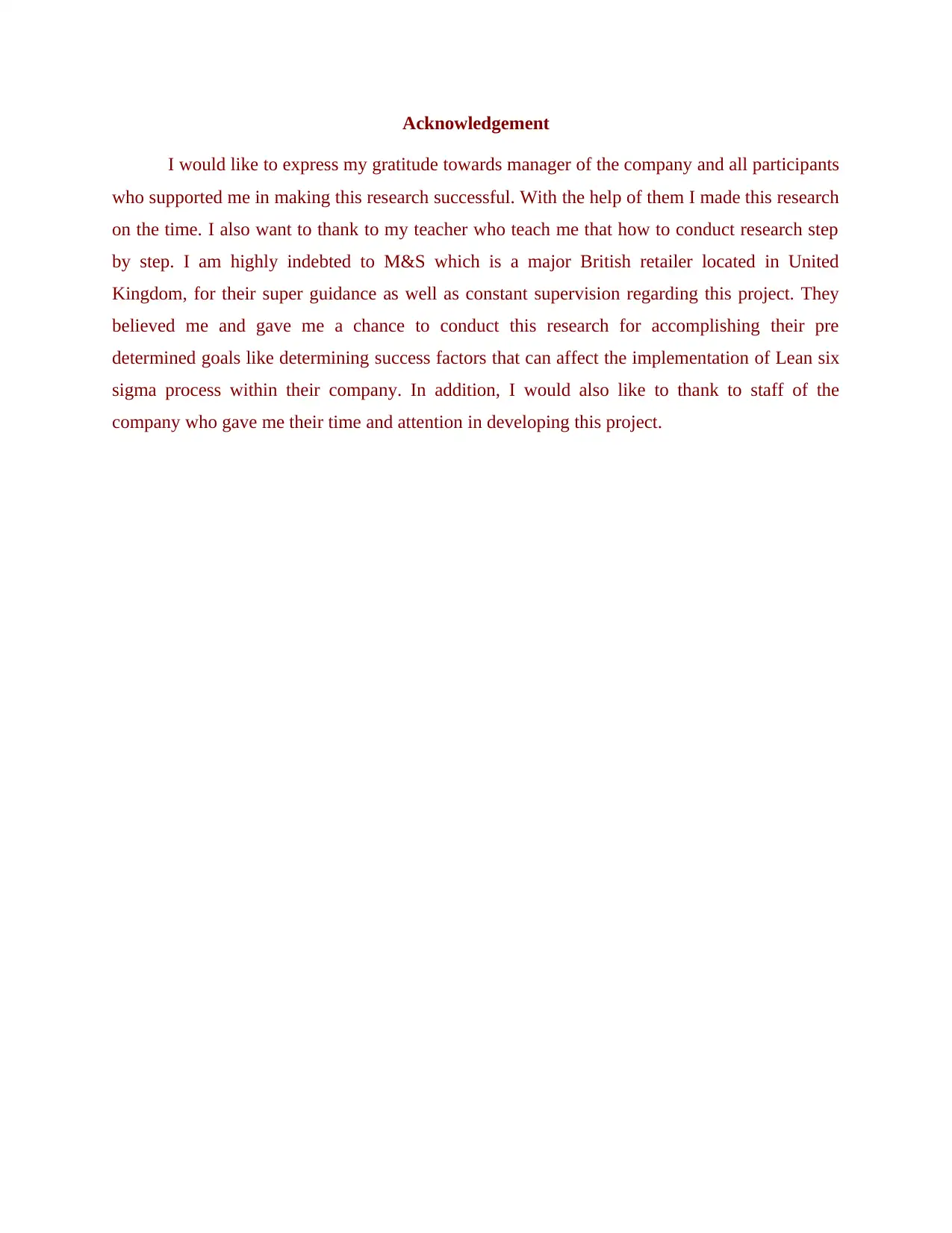
I would like to express my gratitude towards manager of the company and all participants
who supported me in making this research successful. With the help of them I made this research
on the time. I also want to thank to my teacher who teach me that how to conduct research step
by step. I am highly indebted to M&S which is a major British retailer located in United
Kingdom, for their super guidance as well as constant supervision regarding this project. They
believed me and gave me a chance to conduct this research for accomplishing their pre
determined goals like determining success factors that can affect the implementation of Lean six
sigma process within their company. In addition, I would also like to thank to staff of the
company who gave me their time and attention in developing this project.
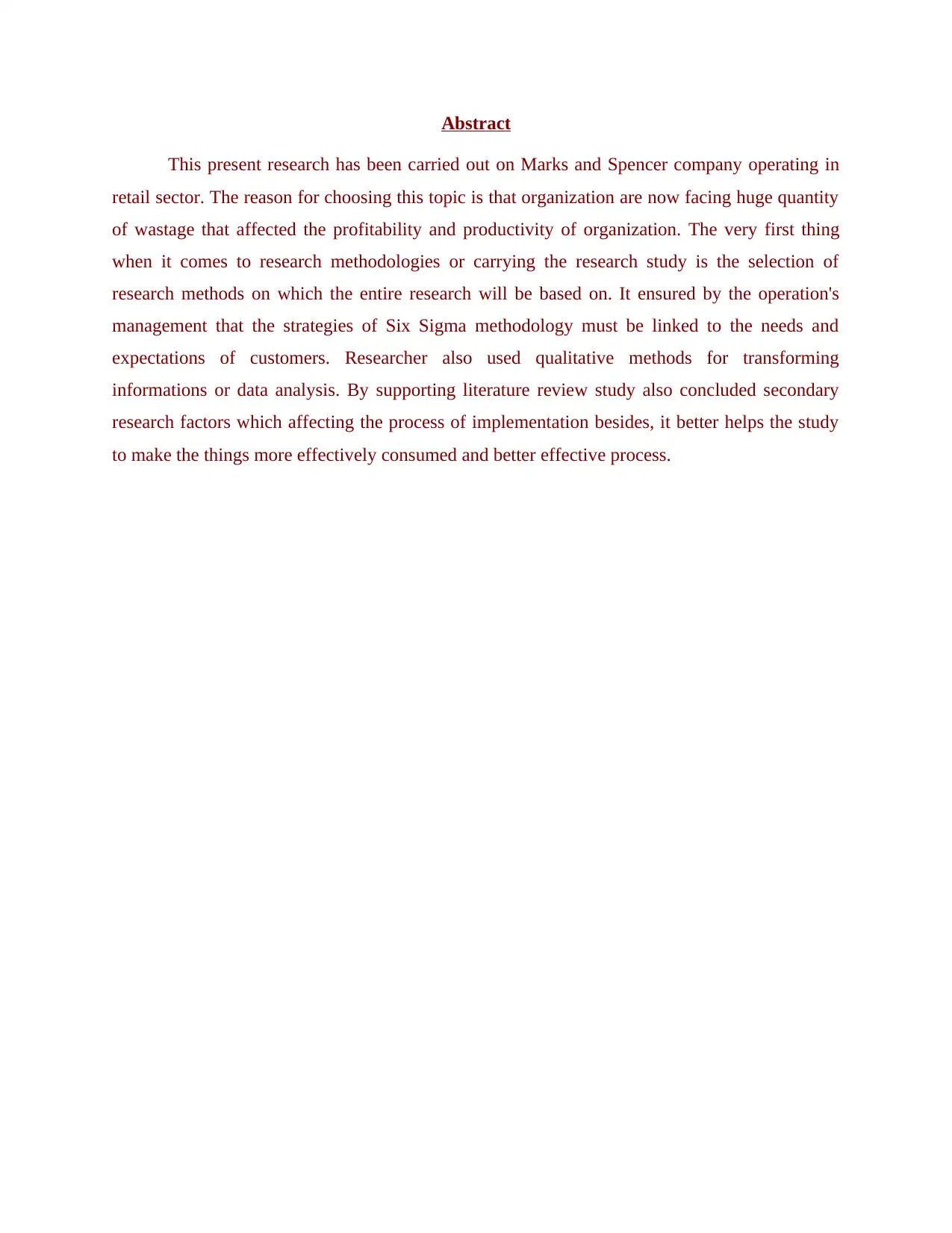
This present research has been carried out on Marks and Spencer company operating in
retail sector. The reason for choosing this topic is that organization are now facing huge quantity
of wastage that affected the profitability and productivity of organization. The very first thing
when it comes to research methodologies or carrying the research study is the selection of
research methods on which the entire research will be based on. It ensured by the operation's
management that the strategies of Six Sigma methodology must be linked to the needs and
expectations of customers. Researcher also used qualitative methods for transforming
informations or data analysis. By supporting literature review study also concluded secondary
research factors which affecting the process of implementation besides, it better helps the study
to make the things more effectively consumed and better effective process.
⊘ This is a preview!⊘
Do you want full access?
Subscribe today to unlock all pages.

Trusted by 1+ million students worldwide

RESEARCH PROPOSAL...............................................................................................................1
TITLE..............................................................................................................................................1
BACKGROUND.............................................................................................................................1
RESEARCH QUESTION, AIMS AND OBJECTIVES.................................................................2
Research Aims:...........................................................................................................................2
Research Objectives:...................................................................................................................2
Research Questions:....................................................................................................................2
LITERATURE REVIEW................................................................................................................2
Theme 1: Concept and usage of Lean Six Sigma methodology.................................................2
Theme 2: Critical success factors affecting the implementation of Lean Six Sigma Approach
within organisation functions and operations in UK retail sector. .............................................3
Theme 3: Complication's organisation faced in the implementation of Lean Six Sigma
methodology................................................................................................................................4
RESEARCH METHODOLOGY.....................................................................................................5
PROJECT PLAN.............................................................................................................................7
RISK MANAGEMENT...................................................................................................................9
CHAPTER 1: INTRODUCTION..................................................................................................11
Introduction to topic..................................................................................................................11
Overview of the company.........................................................................................................11
Problem statement.....................................................................................................................12
Importance of research..............................................................................................................13
Aims And Objectives.....................................................................................................................13
Rationale...................................................................................................................................14
Significance...............................................................................................................................14
CHAPTER 2- LITERATURE REVIEW.......................................................................................15
Theme 1: Concept and usage of Lean Six Sigma methodology...............................................15
Theme 2: Critical success factors affecting the implementation of Lean Six Sigma Approach
...................................................................................................................................................17
Paraphrase This Document
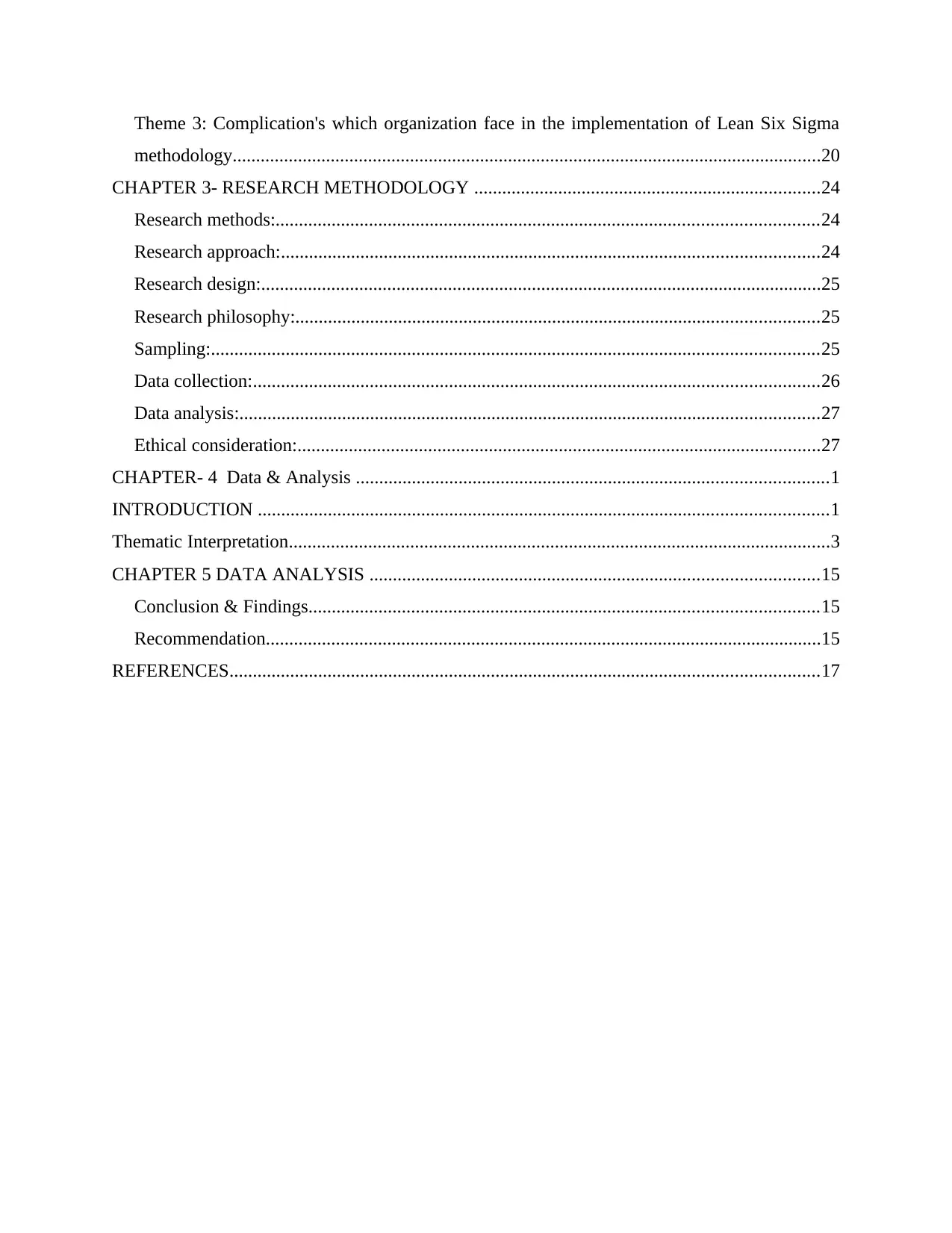
methodology..............................................................................................................................20
CHAPTER 3- RESEARCH METHODOLOGY ..........................................................................24
Research methods:....................................................................................................................24
Research approach:...................................................................................................................24
Research design:........................................................................................................................25
Research philosophy:................................................................................................................25
Sampling:..................................................................................................................................25
Data collection:.........................................................................................................................26
Data analysis:............................................................................................................................27
Ethical consideration:................................................................................................................27
CHAPTER- 4 Data & Analysis .....................................................................................................1
INTRODUCTION ..........................................................................................................................1
Thematic Interpretation....................................................................................................................3
CHAPTER 5 DATA ANALYSIS ................................................................................................15
Conclusion & Findings.............................................................................................................15
Recommendation.......................................................................................................................15
REFERENCES..............................................................................................................................17
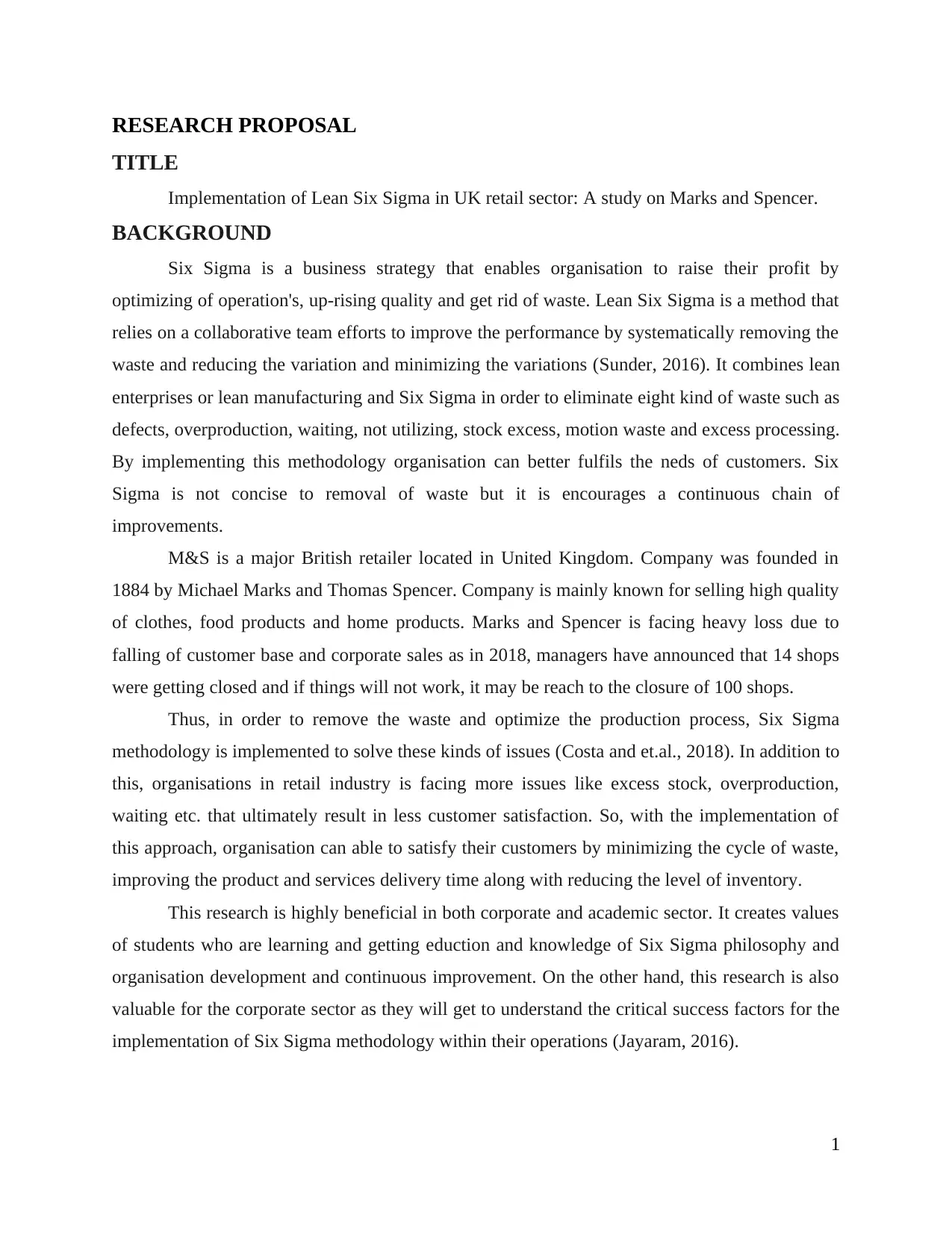
TITLE
Implementation of Lean Six Sigma in UK retail sector: A study on Marks and Spencer.
BACKGROUND
Six Sigma is a business strategy that enables organisation to raise their profit by
optimizing of operation's, up-rising quality and get rid of waste. Lean Six Sigma is a method that
relies on a collaborative team efforts to improve the performance by systematically removing the
waste and reducing the variation and minimizing the variations (Sunder, 2016). It combines lean
enterprises or lean manufacturing and Six Sigma in order to eliminate eight kind of waste such as
defects, overproduction, waiting, not utilizing, stock excess, motion waste and excess processing.
By implementing this methodology organisation can better fulfils the neds of customers. Six
Sigma is not concise to removal of waste but it is encourages a continuous chain of
improvements.
M&S is a major British retailer located in United Kingdom. Company was founded in
1884 by Michael Marks and Thomas Spencer. Company is mainly known for selling high quality
of clothes, food products and home products. Marks and Spencer is facing heavy loss due to
falling of customer base and corporate sales as in 2018, managers have announced that 14 shops
were getting closed and if things will not work, it may be reach to the closure of 100 shops.
Thus, in order to remove the waste and optimize the production process, Six Sigma
methodology is implemented to solve these kinds of issues (Costa and et.al., 2018). In addition to
this, organisations in retail industry is facing more issues like excess stock, overproduction,
waiting etc. that ultimately result in less customer satisfaction. So, with the implementation of
this approach, organisation can able to satisfy their customers by minimizing the cycle of waste,
improving the product and services delivery time along with reducing the level of inventory.
This research is highly beneficial in both corporate and academic sector. It creates values
of students who are learning and getting eduction and knowledge of Six Sigma philosophy and
organisation development and continuous improvement. On the other hand, this research is also
valuable for the corporate sector as they will get to understand the critical success factors for the
implementation of Six Sigma methodology within their operations (Jayaram, 2016).
1
⊘ This is a preview!⊘
Do you want full access?
Subscribe today to unlock all pages.

Trusted by 1+ million students worldwide

Research Aims:
“To determine the critical success factors affecting the implementation of Lean Six Sigma
within organisation operation and functions in UK retail sector. A study on H&M”.
Research Objectives:
To comprehend the concept and usage of Lean Six Sigma methodology.
To determine the critical success factors affecting the implementation of Lean Six Sigma
Approach within organization functions and operations in UK retail sector.
To identify the complication's organization faced in the implementation of Lean Six
Sigma methodology.
To provide ways for the effective implementation of Lean Six Sigma Methodology.
Research Questions:
11 What is the concept and usage of Lean Six Sigma methodology?
11 What are the critical success factors affecting the implementation of Lean Six Sigma
Approach within organisation functions and operations in UK retail sector?
11 What are the complication's organisation faced in the implementation of Lean Six Sigma
methodology?
11 What are the ways for the effective implementation of Lean Six Sigma Methodology?
LITERATURE REVIEW
Theme 1: Concept and usage of Lean Six Sigma methodology.
According to the Muturi and et.al., (2015) Six Sigma methodology is a tool and
techniques which is used to improve the process of manufacturing. This approach of continuous
improvement mainly relies on the collaborative efforts of team members in order to improve the
performance of the organization by systematically removing the waste as well as minimizing the
differences. The main purpose of using this approach is that is make sure the standard quality
and better customer satisfaction. The main intention of implementing or using this approach is
not only eliminating all those things which do not contribute to what customers is willing to pay
for. But Mason, Nicolay and Darzi, (2015) argued that, six sigma the processes and system of
2
Paraphrase This Document
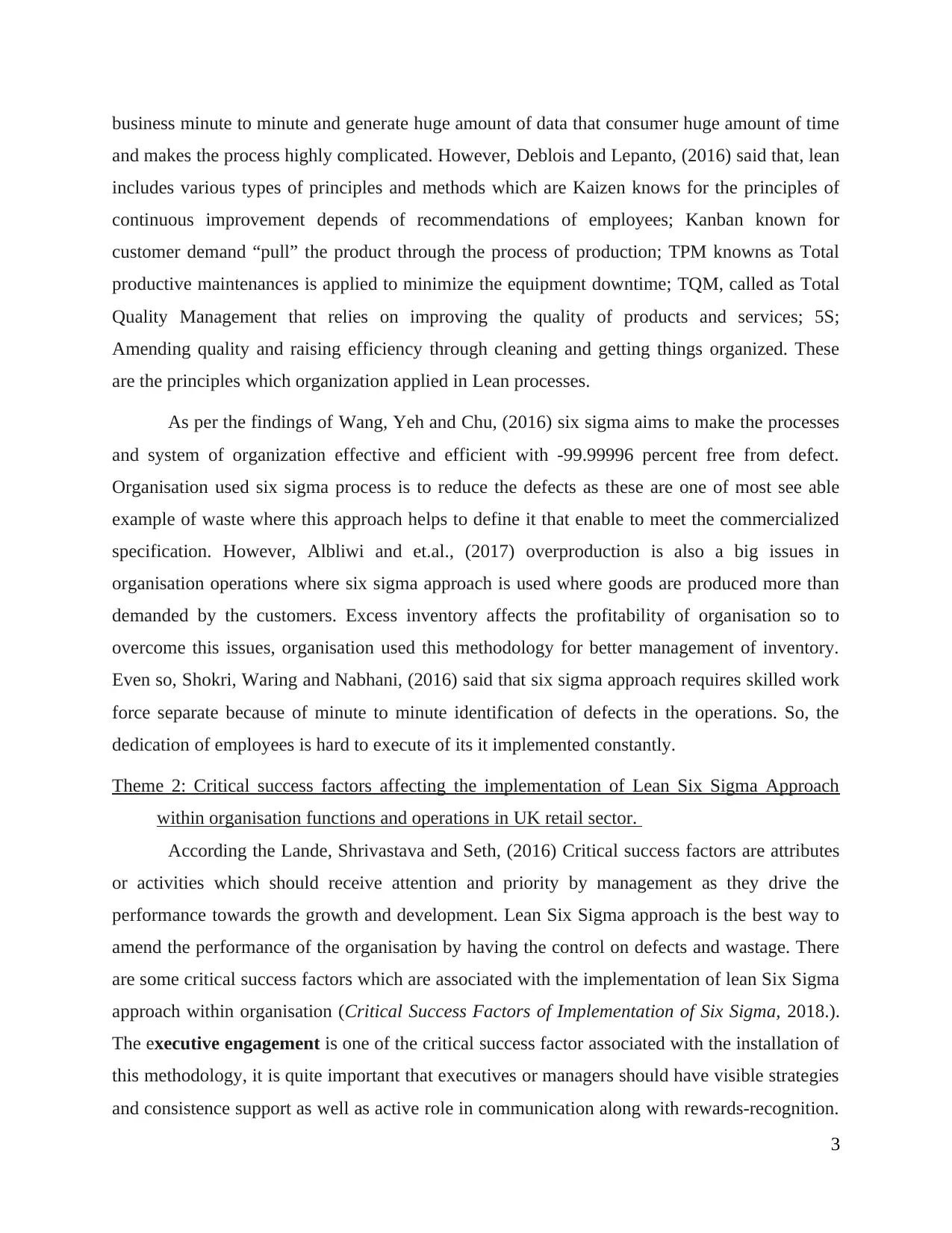
and makes the process highly complicated. However, Deblois and Lepanto, (2016) said that, lean
includes various types of principles and methods which are Kaizen knows for the principles of
continuous improvement depends of recommendations of employees; Kanban known for
customer demand “pull” the product through the process of production; TPM knowns as Total
productive maintenances is applied to minimize the equipment downtime; TQM, called as Total
Quality Management that relies on improving the quality of products and services; 5S;
Amending quality and raising efficiency through cleaning and getting things organized. These
are the principles which organization applied in Lean processes.
As per the findings of Wang, Yeh and Chu, (2016) six sigma aims to make the processes
and system of organization effective and efficient with -99.99996 percent free from defect.
Organisation used six sigma process is to reduce the defects as these are one of most see able
example of waste where this approach helps to define it that enable to meet the commercialized
specification. However, Albliwi and et.al., (2017) overproduction is also a big issues in
organisation operations where six sigma approach is used where goods are produced more than
demanded by the customers. Excess inventory affects the profitability of organisation so to
overcome this issues, organisation used this methodology for better management of inventory.
Even so, Shokri, Waring and Nabhani, (2016) said that six sigma approach requires skilled work
force separate because of minute to minute identification of defects in the operations. So, the
dedication of employees is hard to execute of its it implemented constantly.
Theme 2: Critical success factors affecting the implementation of Lean Six Sigma Approach
within organisation functions and operations in UK retail sector.
According the Lande, Shrivastava and Seth, (2016) Critical success factors are attributes
or activities which should receive attention and priority by management as they drive the
performance towards the growth and development. Lean Six Sigma approach is the best way to
amend the performance of the organisation by having the control on defects and wastage. There
are some critical success factors which are associated with the implementation of lean Six Sigma
approach within organisation (Critical Success Factors of Implementation of Six Sigma, 2018.).
The executive engagement is one of the critical success factor associated with the installation of
this methodology, it is quite important that executives or managers should have visible strategies
and consistence support as well as active role in communication along with rewards-recognition.
3
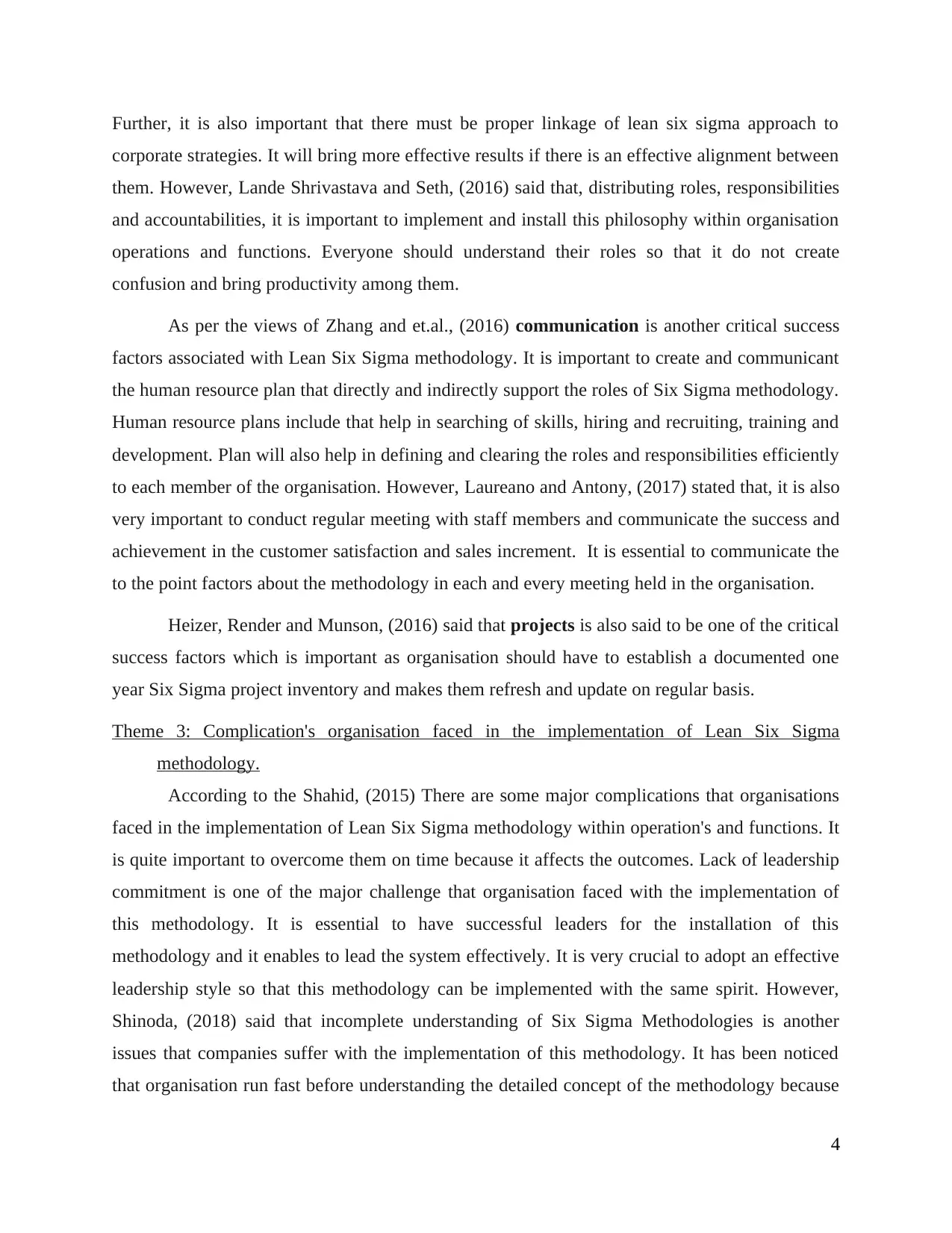
corporate strategies. It will bring more effective results if there is an effective alignment between
them. However, Lande Shrivastava and Seth, (2016) said that, distributing roles, responsibilities
and accountabilities, it is important to implement and install this philosophy within organisation
operations and functions. Everyone should understand their roles so that it do not create
confusion and bring productivity among them.
As per the views of Zhang and et.al., (2016) communication is another critical success
factors associated with Lean Six Sigma methodology. It is important to create and communicant
the human resource plan that directly and indirectly support the roles of Six Sigma methodology.
Human resource plans include that help in searching of skills, hiring and recruiting, training and
development. Plan will also help in defining and clearing the roles and responsibilities efficiently
to each member of the organisation. However, Laureano and Antony, (2017) stated that, it is also
very important to conduct regular meeting with staff members and communicate the success and
achievement in the customer satisfaction and sales increment. It is essential to communicate the
to the point factors about the methodology in each and every meeting held in the organisation.
Heizer, Render and Munson, (2016) said that projects is also said to be one of the critical
success factors which is important as organisation should have to establish a documented one
year Six Sigma project inventory and makes them refresh and update on regular basis.
Theme 3: Complication's organisation faced in the implementation of Lean Six Sigma
methodology.
According to the Shahid, (2015) There are some major complications that organisations
faced in the implementation of Lean Six Sigma methodology within operation's and functions. It
is quite important to overcome them on time because it affects the outcomes. Lack of leadership
commitment is one of the major challenge that organisation faced with the implementation of
this methodology. It is essential to have successful leaders for the installation of this
methodology and it enables to lead the system effectively. It is very crucial to adopt an effective
leadership style so that this methodology can be implemented with the same spirit. However,
Shinoda, (2018) said that incomplete understanding of Six Sigma Methodologies is another
issues that companies suffer with the implementation of this methodology. It has been noticed
that organisation run fast before understanding the detailed concept of the methodology because
4
⊘ This is a preview!⊘
Do you want full access?
Subscribe today to unlock all pages.

Trusted by 1+ million students worldwide
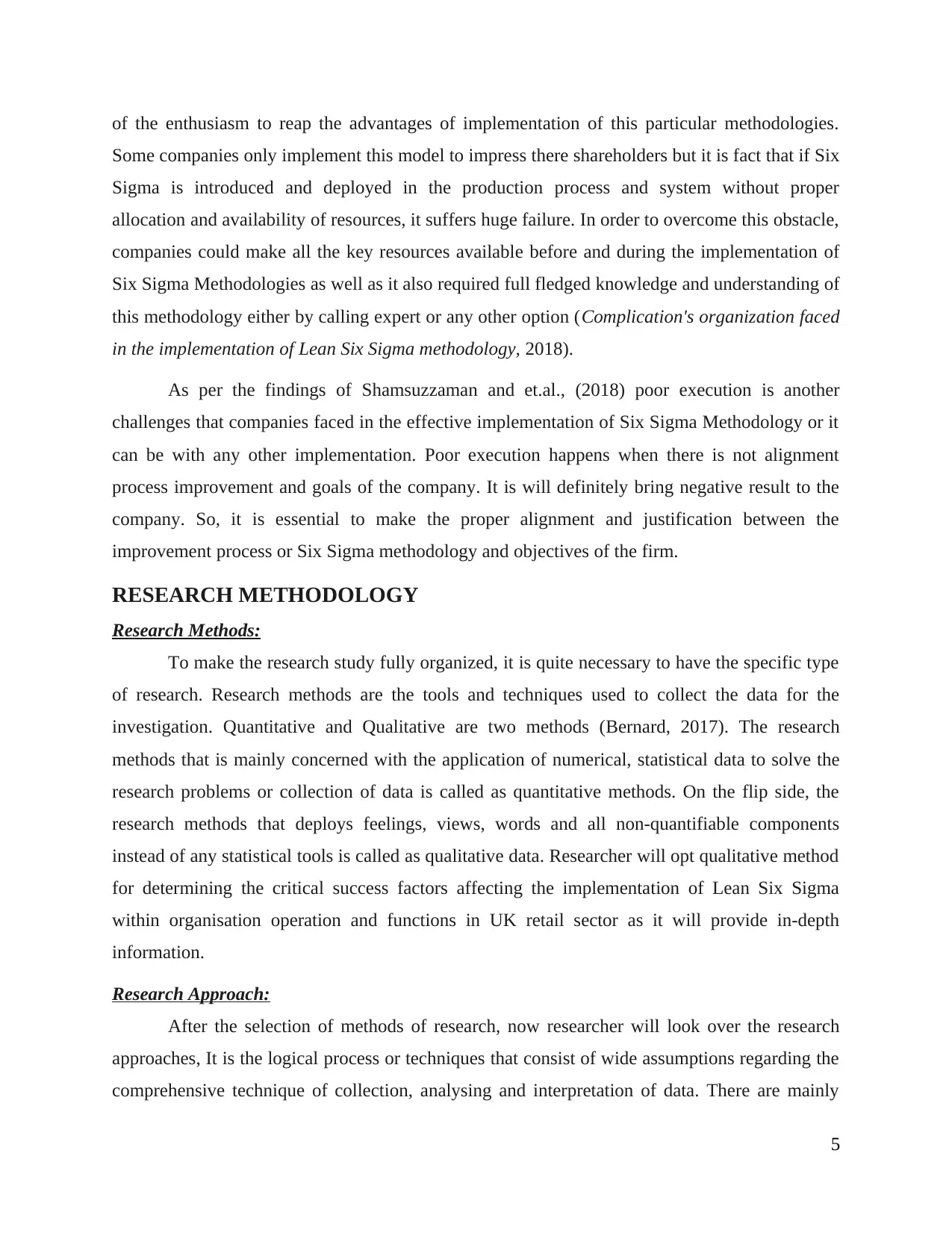
Some companies only implement this model to impress there shareholders but it is fact that if Six
Sigma is introduced and deployed in the production process and system without proper
allocation and availability of resources, it suffers huge failure. In order to overcome this obstacle,
companies could make all the key resources available before and during the implementation of
Six Sigma Methodologies as well as it also required full fledged knowledge and understanding of
this methodology either by calling expert or any other option (Complication's organization faced
in the implementation of Lean Six Sigma methodology, 2018).
As per the findings of Shamsuzzaman and et.al., (2018) poor execution is another
challenges that companies faced in the effective implementation of Six Sigma Methodology or it
can be with any other implementation. Poor execution happens when there is not alignment
process improvement and goals of the company. It is will definitely bring negative result to the
company. So, it is essential to make the proper alignment and justification between the
improvement process or Six Sigma methodology and objectives of the firm.
RESEARCH METHODOLOGY
Research Methods:
To make the research study fully organized, it is quite necessary to have the specific type
of research. Research methods are the tools and techniques used to collect the data for the
investigation. Quantitative and Qualitative are two methods (Bernard, 2017). The research
methods that is mainly concerned with the application of numerical, statistical data to solve the
research problems or collection of data is called as quantitative methods. On the flip side, the
research methods that deploys feelings, views, words and all non-quantifiable components
instead of any statistical tools is called as qualitative data. Researcher will opt qualitative method
for determining the critical success factors affecting the implementation of Lean Six Sigma
within organisation operation and functions in UK retail sector as it will provide in-depth
information.
Research Approach:
After the selection of methods of research, now researcher will look over the research
approaches, It is the logical process or techniques that consist of wide assumptions regarding the
comprehensive technique of collection, analysing and interpretation of data. There are mainly
5
Paraphrase This Document
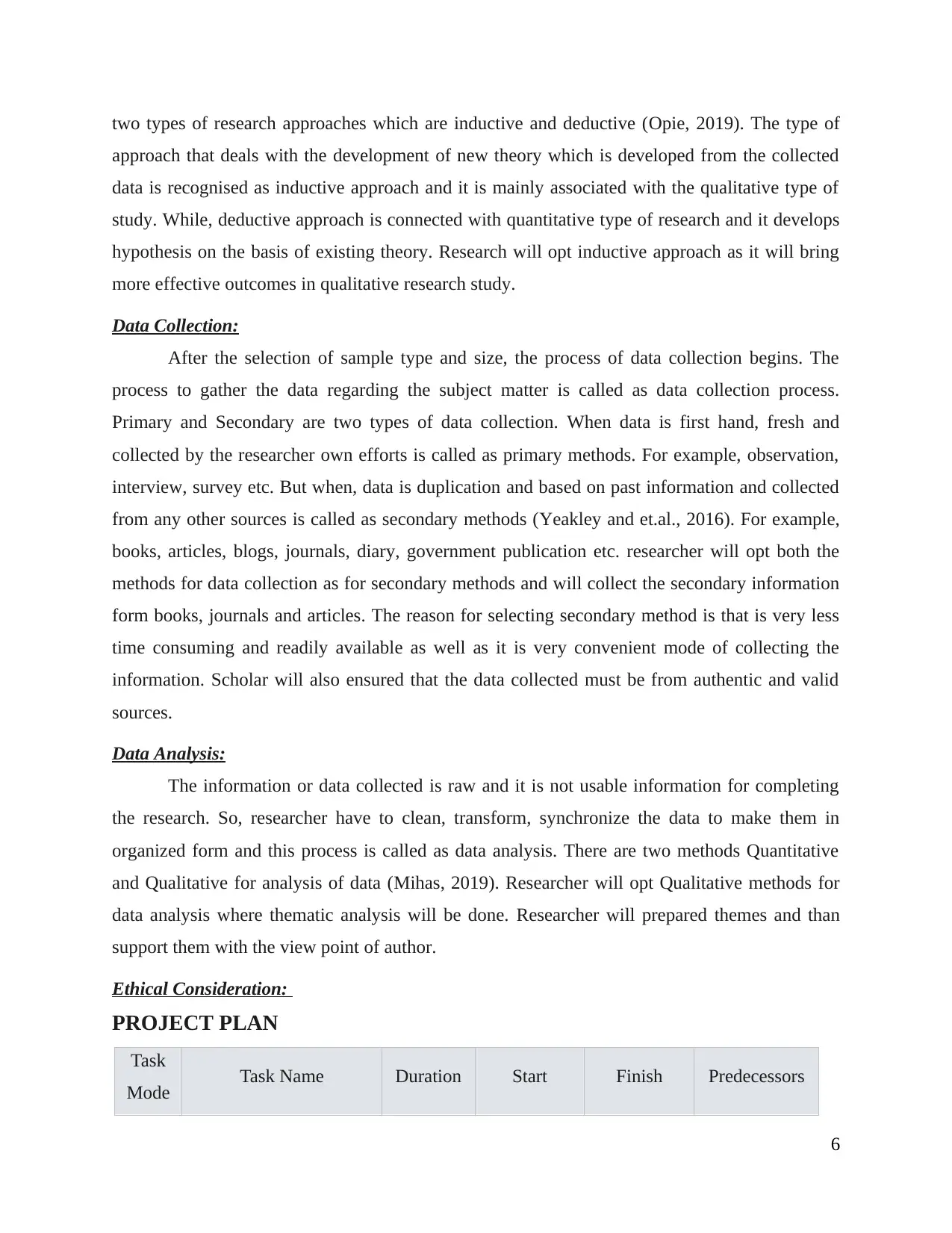
approach that deals with the development of new theory which is developed from the collected
data is recognised as inductive approach and it is mainly associated with the qualitative type of
study. While, deductive approach is connected with quantitative type of research and it develops
hypothesis on the basis of existing theory. Research will opt inductive approach as it will bring
more effective outcomes in qualitative research study.
Data Collection:
After the selection of sample type and size, the process of data collection begins. The
process to gather the data regarding the subject matter is called as data collection process.
Primary and Secondary are two types of data collection. When data is first hand, fresh and
collected by the researcher own efforts is called as primary methods. For example, observation,
interview, survey etc. But when, data is duplication and based on past information and collected
from any other sources is called as secondary methods (Yeakley and et.al., 2016). For example,
books, articles, blogs, journals, diary, government publication etc. researcher will opt both the
methods for data collection as for secondary methods and will collect the secondary information
form books, journals and articles. The reason for selecting secondary method is that is very less
time consuming and readily available as well as it is very convenient mode of collecting the
information. Scholar will also ensured that the data collected must be from authentic and valid
sources.
Data Analysis:
The information or data collected is raw and it is not usable information for completing
the research. So, researcher have to clean, transform, synchronize the data to make them in
organized form and this process is called as data analysis. There are two methods Quantitative
and Qualitative for analysis of data (Mihas, 2019). Researcher will opt Qualitative methods for
data analysis where thematic analysis will be done. Researcher will prepared themes and than
support them with the view point of author.
Ethical Consideration:
PROJECT PLAN
Task
Mode Task Name Duration Start Finish Predecessors
6
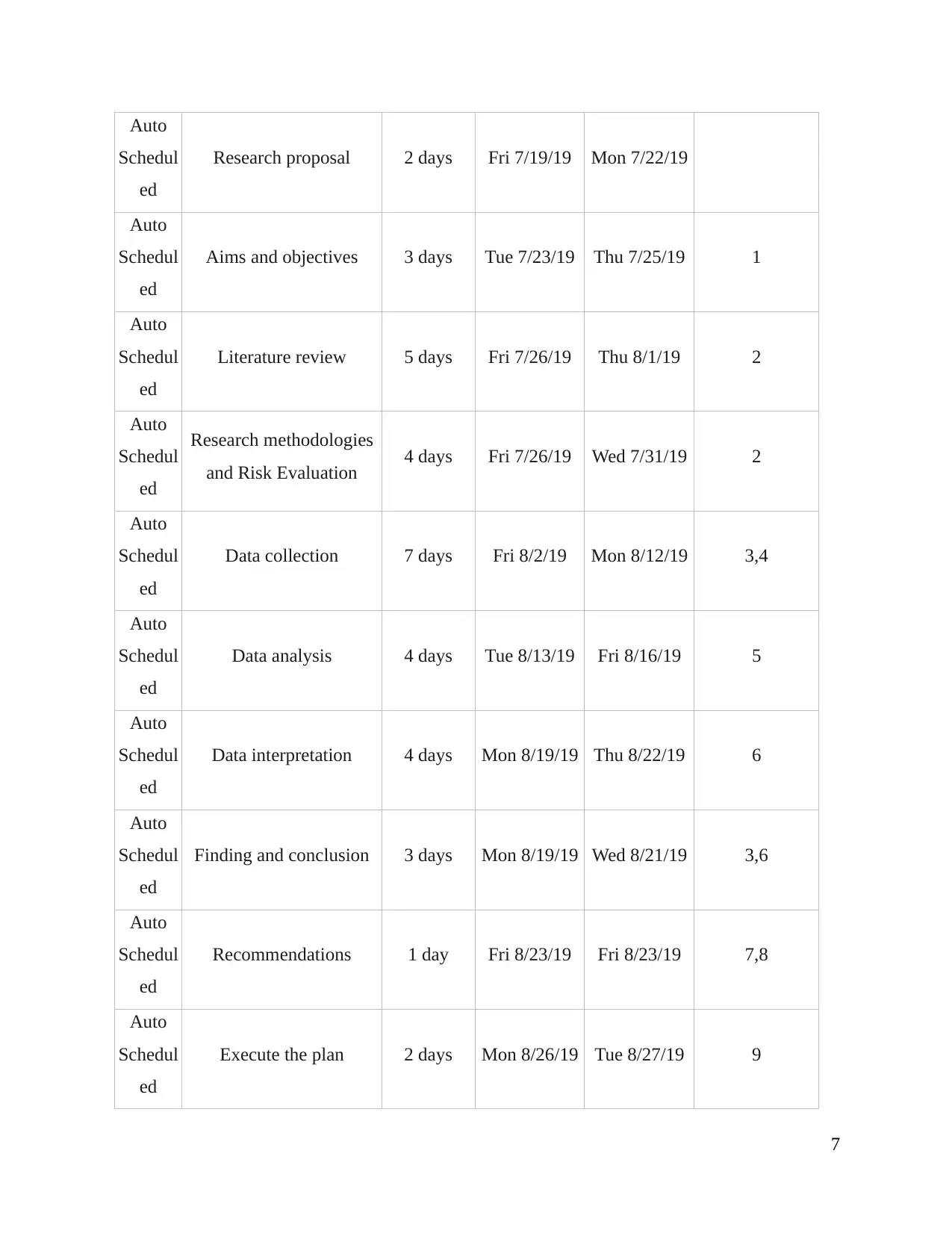
Schedul
ed
Research proposal 2 days Fri 7/19/19 Mon 7/22/19
Auto
Schedul
ed
Aims and objectives 3 days Tue 7/23/19 Thu 7/25/19 1
Auto
Schedul
ed
Literature review 5 days Fri 7/26/19 Thu 8/1/19 2
Auto
Schedul
ed
Research methodologies
and Risk Evaluation 4 days Fri 7/26/19 Wed 7/31/19 2
Auto
Schedul
ed
Data collection 7 days Fri 8/2/19 Mon 8/12/19 3,4
Auto
Schedul
ed
Data analysis 4 days Tue 8/13/19 Fri 8/16/19 5
Auto
Schedul
ed
Data interpretation 4 days Mon 8/19/19 Thu 8/22/19 6
Auto
Schedul
ed
Finding and conclusion 3 days Mon 8/19/19 Wed 8/21/19 3,6
Auto
Schedul
ed
Recommendations 1 day Fri 8/23/19 Fri 8/23/19 7,8
Auto
Schedul
ed
Execute the plan 2 days Mon 8/26/19 Tue 8/27/19 9
7
⊘ This is a preview!⊘
Do you want full access?
Subscribe today to unlock all pages.

Trusted by 1+ million students worldwide
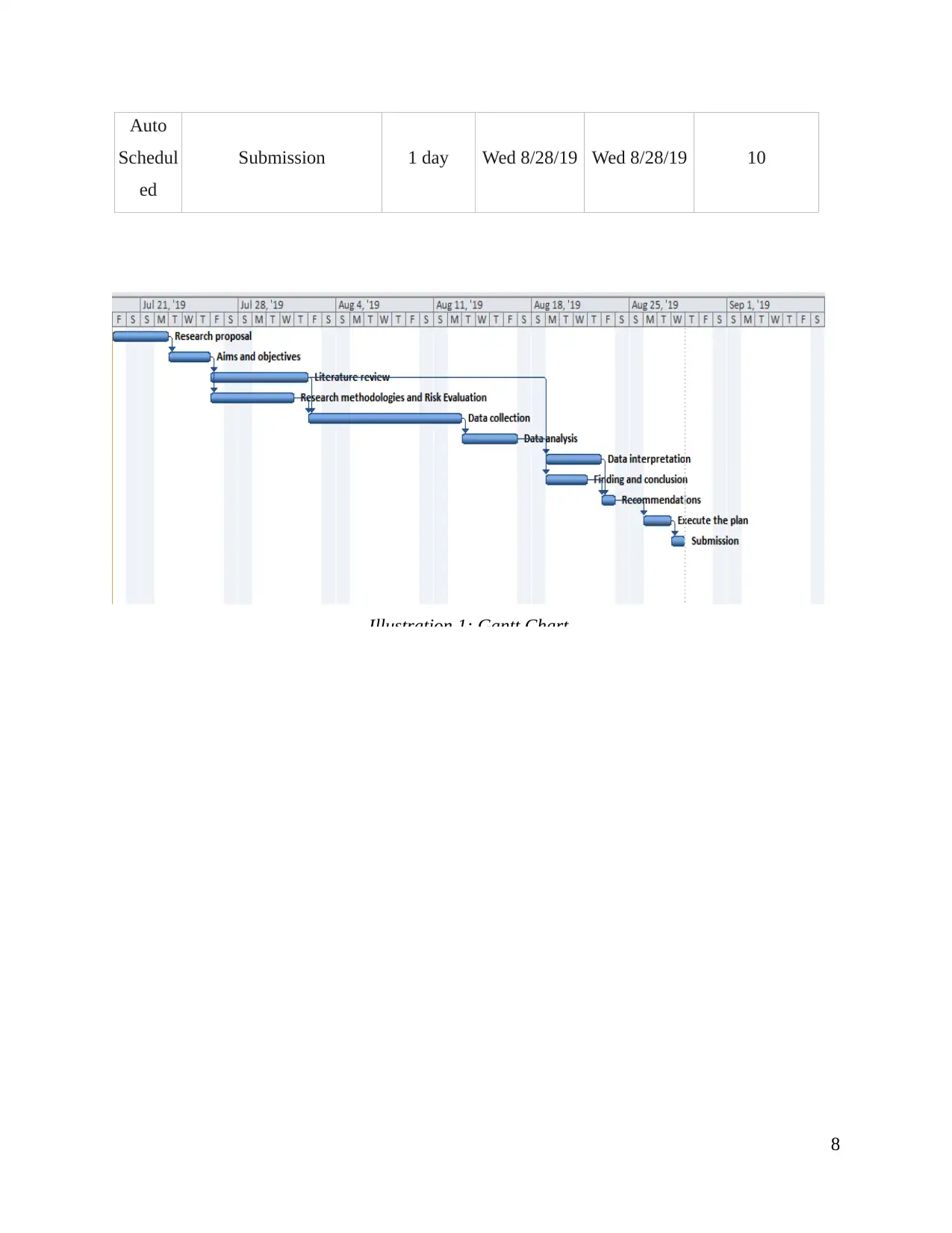
Schedul
ed
Submission 1 day Wed 8/28/19 Wed 8/28/19 10
Illustration 1: Gantt Chart
8
Paraphrase This Document
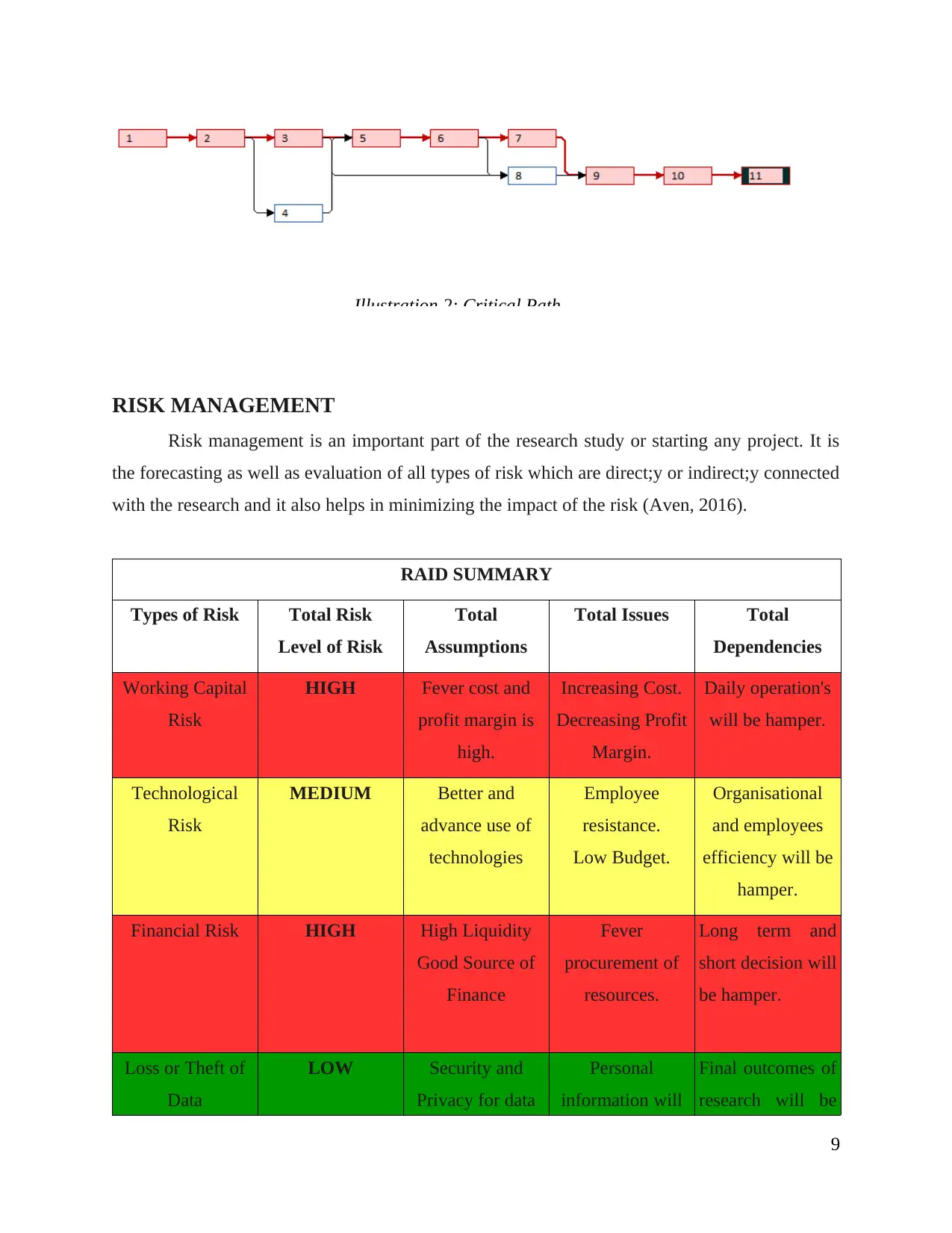
RISK MANAGEMENT
Risk management is an important part of the research study or starting any project. It is
the forecasting as well as evaluation of all types of risk which are direct;y or indirect;y connected
with the research and it also helps in minimizing the impact of the risk (Aven, 2016).
RAID SUMMARY
Types of Risk Total Risk
Level of Risk
Total
Assumptions
Total Issues Total
Dependencies
Working Capital
Risk
HIGH Fever cost and
profit margin is
high.
Increasing Cost.
Decreasing Profit
Margin.
Daily operation's
will be hamper.
Technological
Risk
MEDIUM Better and
advance use of
technologies
Employee
resistance.
Low Budget.
Organisational
and employees
efficiency will be
hamper.
Financial Risk HIGH High Liquidity
Good Source of
Finance
Fever
procurement of
resources.
Long term and
short decision will
be hamper.
Loss or Theft of
Data
LOW Security and
Privacy for data
Personal
information will
Final outcomes of
research will be
9
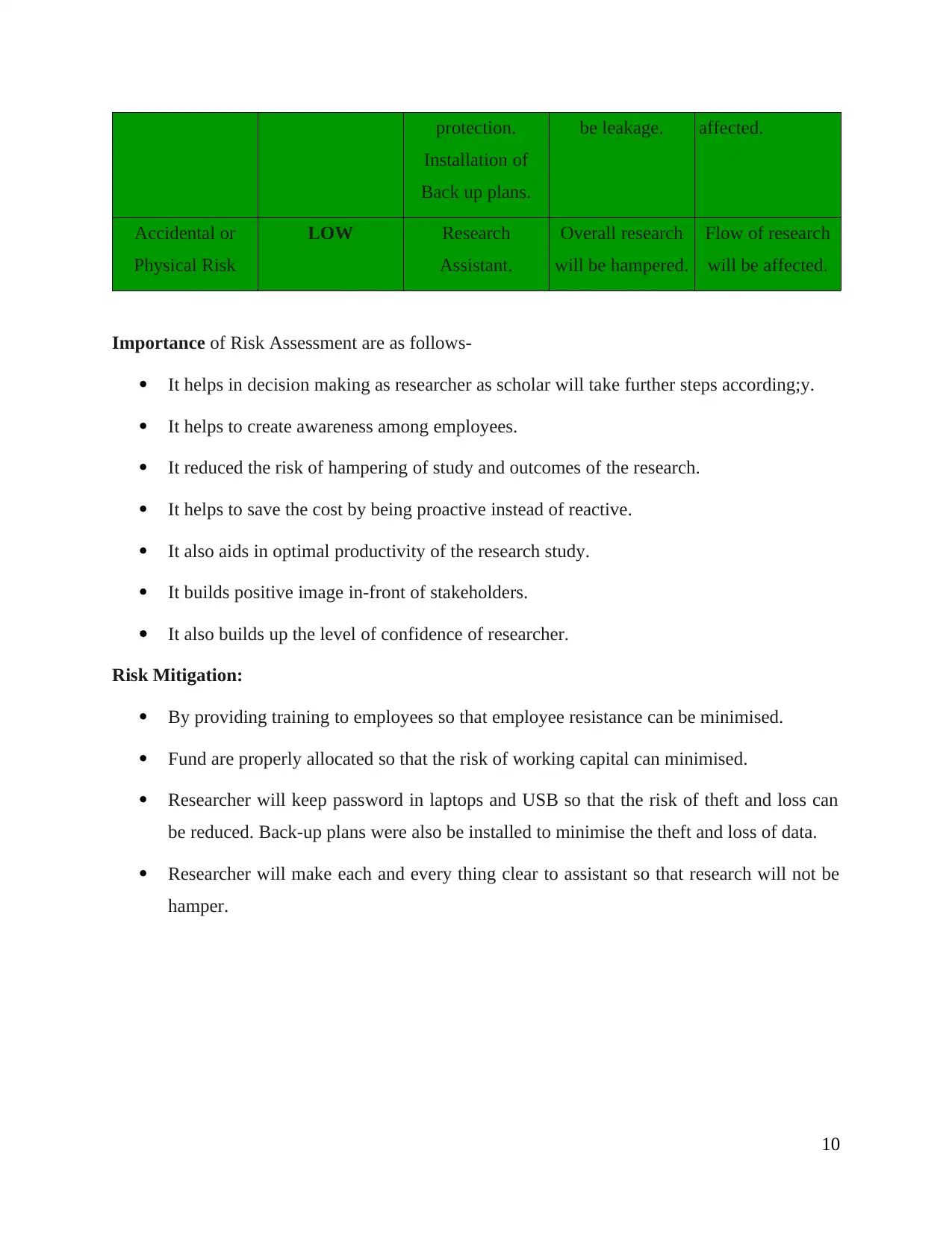
Installation of
Back up plans.
be leakage. affected.
Accidental or
Physical Risk
LOW Research
Assistant.
Overall research
will be hampered.
Flow of research
will be affected.
Importance of Risk Assessment are as follows-
It helps in decision making as researcher as scholar will take further steps according;y.
It helps to create awareness among employees.
It reduced the risk of hampering of study and outcomes of the research.
It helps to save the cost by being proactive instead of reactive.
It also aids in optimal productivity of the research study.
It builds positive image in-front of stakeholders.
It also builds up the level of confidence of researcher.
Risk Mitigation:
By providing training to employees so that employee resistance can be minimised.
Fund are properly allocated so that the risk of working capital can minimised.
Researcher will keep password in laptops and USB so that the risk of theft and loss can
be reduced. Back-up plans were also be installed to minimise the theft and loss of data.
Researcher will make each and every thing clear to assistant so that research will not be
hamper.
10
⊘ This is a preview!⊘
Do you want full access?
Subscribe today to unlock all pages.

Trusted by 1+ million students worldwide
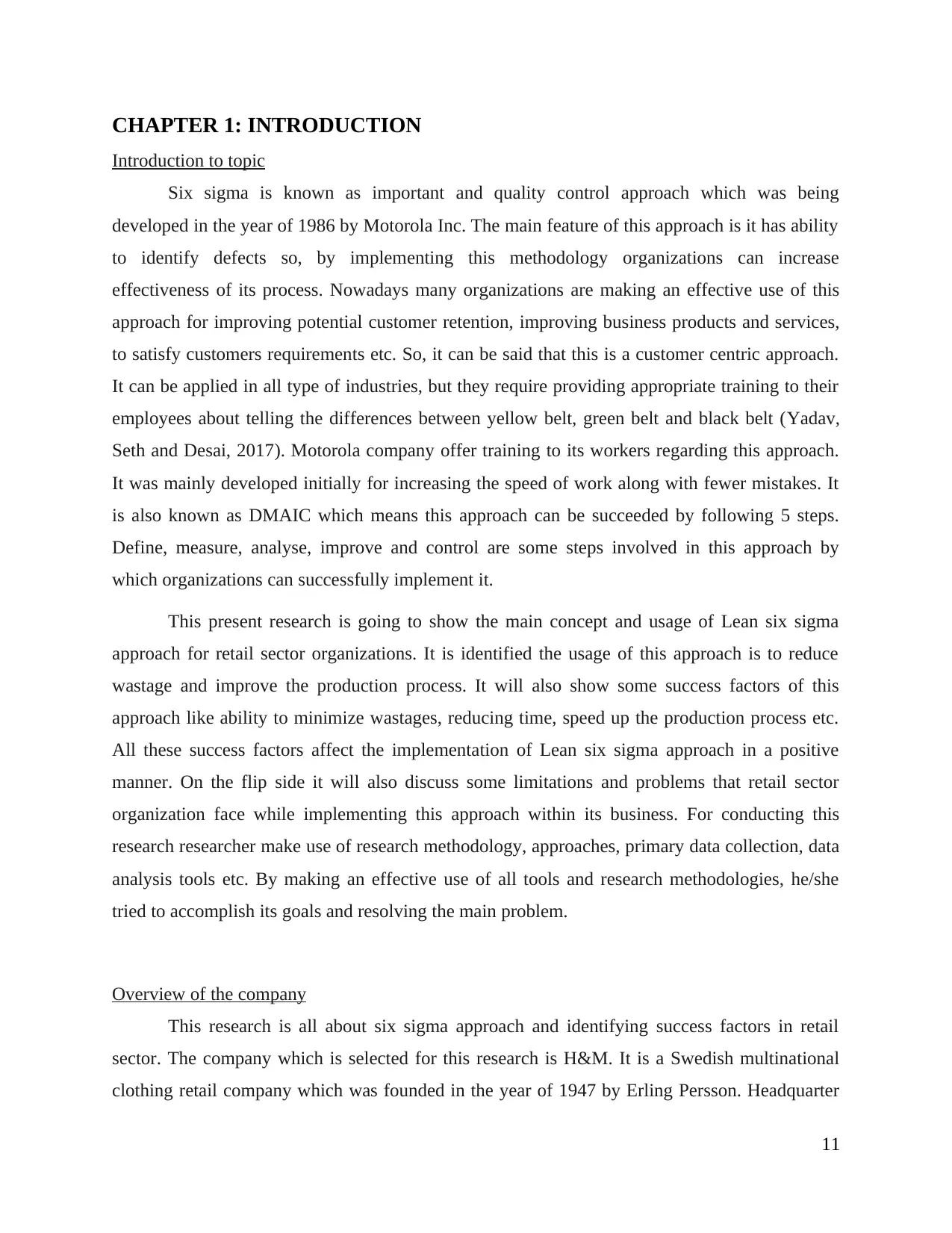
Introduction to topic
Six sigma is known as important and quality control approach which was being
developed in the year of 1986 by Motorola Inc. The main feature of this approach is it has ability
to identify defects so, by implementing this methodology organizations can increase
effectiveness of its process. Nowadays many organizations are making an effective use of this
approach for improving potential customer retention, improving business products and services,
to satisfy customers requirements etc. So, it can be said that this is a customer centric approach.
It can be applied in all type of industries, but they require providing appropriate training to their
employees about telling the differences between yellow belt, green belt and black belt (Yadav,
Seth and Desai, 2017). Motorola company offer training to its workers regarding this approach.
It was mainly developed initially for increasing the speed of work along with fewer mistakes. It
is also known as DMAIC which means this approach can be succeeded by following 5 steps.
Define, measure, analyse, improve and control are some steps involved in this approach by
which organizations can successfully implement it.
This present research is going to show the main concept and usage of Lean six sigma
approach for retail sector organizations. It is identified the usage of this approach is to reduce
wastage and improve the production process. It will also show some success factors of this
approach like ability to minimize wastages, reducing time, speed up the production process etc.
All these success factors affect the implementation of Lean six sigma approach in a positive
manner. On the flip side it will also discuss some limitations and problems that retail sector
organization face while implementing this approach within its business. For conducting this
research researcher make use of research methodology, approaches, primary data collection, data
analysis tools etc. By making an effective use of all tools and research methodologies, he/she
tried to accomplish its goals and resolving the main problem.
Overview of the company
This research is all about six sigma approach and identifying success factors in retail
sector. The company which is selected for this research is H&M. It is a Swedish multinational
clothing retail company which was founded in the year of 1947 by Erling Persson. Headquarter
11
Paraphrase This Document
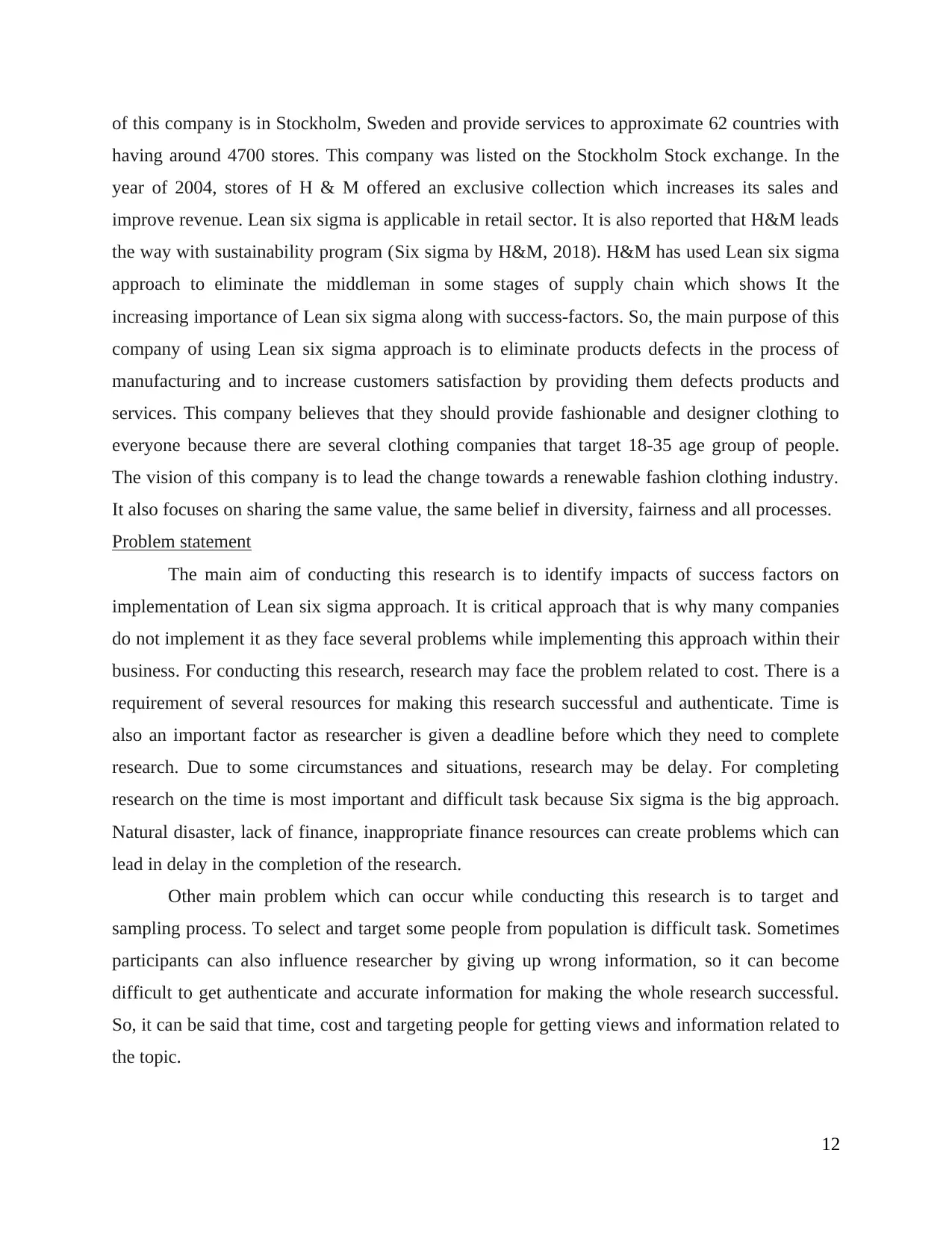
having around 4700 stores. This company was listed on the Stockholm Stock exchange. In the
year of 2004, stores of H & M offered an exclusive collection which increases its sales and
improve revenue. Lean six sigma is applicable in retail sector. It is also reported that H&M leads
the way with sustainability program (Six sigma by H&M, 2018). H&M has used Lean six sigma
approach to eliminate the middleman in some stages of supply chain which shows It the
increasing importance of Lean six sigma along with success-factors. So, the main purpose of this
company of using Lean six sigma approach is to eliminate products defects in the process of
manufacturing and to increase customers satisfaction by providing them defects products and
services. This company believes that they should provide fashionable and designer clothing to
everyone because there are several clothing companies that target 18-35 age group of people.
The vision of this company is to lead the change towards a renewable fashion clothing industry.
It also focuses on sharing the same value, the same belief in diversity, fairness and all processes.
Problem statement
The main aim of conducting this research is to identify impacts of success factors on
implementation of Lean six sigma approach. It is critical approach that is why many companies
do not implement it as they face several problems while implementing this approach within their
business. For conducting this research, research may face the problem related to cost. There is a
requirement of several resources for making this research successful and authenticate. Time is
also an important factor as researcher is given a deadline before which they need to complete
research. Due to some circumstances and situations, research may be delay. For completing
research on the time is most important and difficult task because Six sigma is the big approach.
Natural disaster, lack of finance, inappropriate finance resources can create problems which can
lead in delay in the completion of the research.
Other main problem which can occur while conducting this research is to target and
sampling process. To select and target some people from population is difficult task. Sometimes
participants can also influence researcher by giving up wrong information, so it can become
difficult to get authenticate and accurate information for making the whole research successful.
So, it can be said that time, cost and targeting people for getting views and information related to
the topic.
12

Research is all about identifying success factors that affect the implementation of Lean
six sigma approach. H&M company wants to take competitive advantages and wants to become
market leader in fashion retail industry. The vision of this company is to make available
fashionable brand for all and satisfying customers. Research plays an important role in
accomplishing goals, so by conducting research, researcher can follow several steps which can
help the company in identifying the main problem along with its solutions. A successful research
includes some steps that needs to be followed in a systematic manner. When a researcher follows
all those steps systematic then it can accomplish any type of goal.
For this research, scholar will identify the main concept and importance of six sigma
approach. It will also identify some limitations and complications which the company can face
while implementing this approach. So, the main aim and importance of conducting research is to
resolve all those problems that are related to six sigma approach and increase customers
satisfaction. By conducting this research, H&M can accomplish its pre-determined aim and
objectives.
Aims And Objectives
Aim:
“To identify the impacts of innovative marketing strategies on profitability and sales
volume of a company. Research is based on Binary trends”.
Objectives:
To identify the current marketing strategies of Binary trends.
To understand the contribution of marketing strategies on profitability and sales.
To examine the roles of innovation in exploring marketing opportunities.
To recommend the ways through which innovation can be implemented within Binary
trends.
Rationale
One of the main reason of conducting investigation on critical success factor that affect
implementation of lean six sigma within organization operation and functions in UK is that it is
13
⊘ This is a preview!⊘
Do you want full access?
Subscribe today to unlock all pages.

Trusted by 1+ million students worldwide
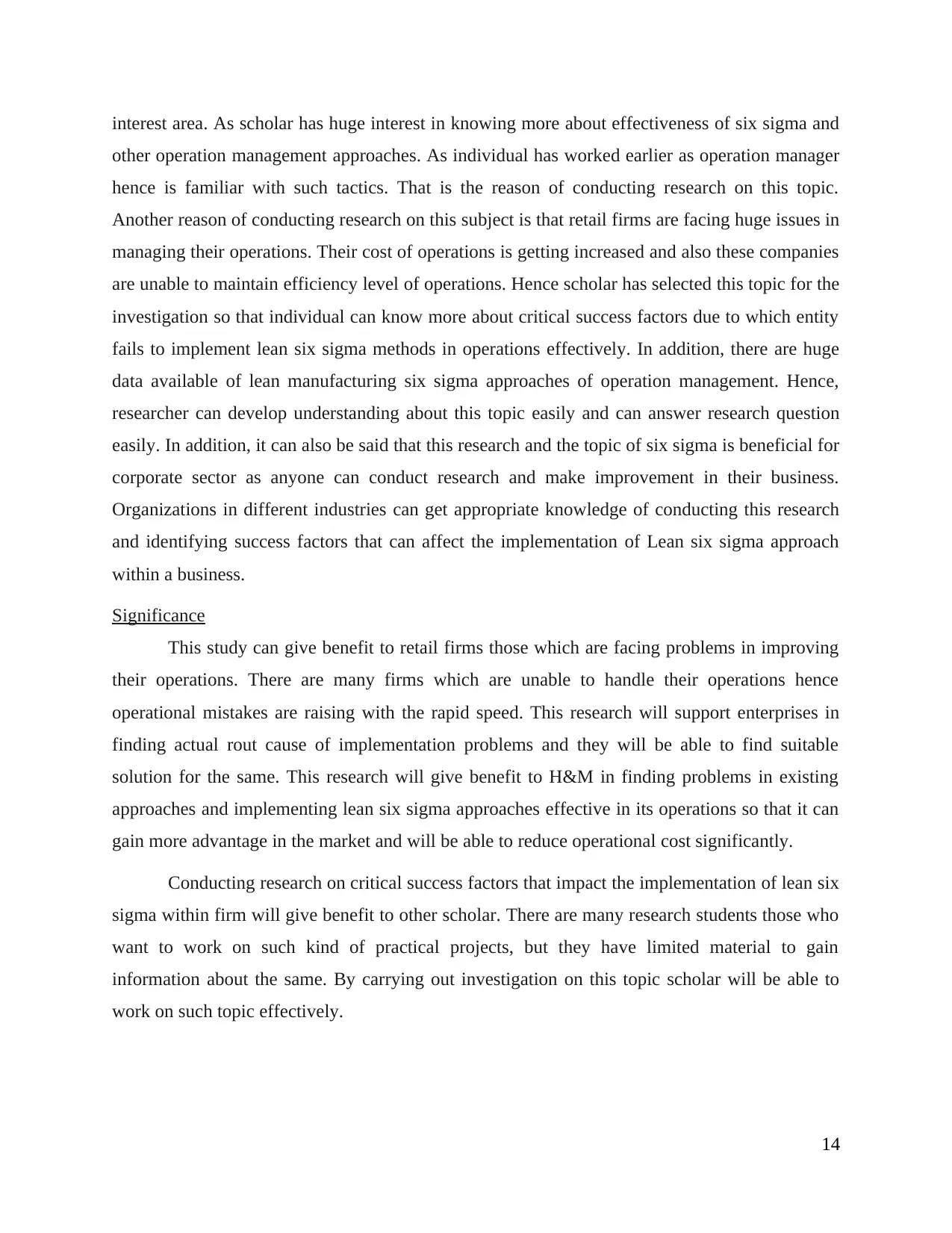
other operation management approaches. As individual has worked earlier as operation manager
hence is familiar with such tactics. That is the reason of conducting research on this topic.
Another reason of conducting research on this subject is that retail firms are facing huge issues in
managing their operations. Their cost of operations is getting increased and also these companies
are unable to maintain efficiency level of operations. Hence scholar has selected this topic for the
investigation so that individual can know more about critical success factors due to which entity
fails to implement lean six sigma methods in operations effectively. In addition, there are huge
data available of lean manufacturing six sigma approaches of operation management. Hence,
researcher can develop understanding about this topic easily and can answer research question
easily. In addition, it can also be said that this research and the topic of six sigma is beneficial for
corporate sector as anyone can conduct research and make improvement in their business.
Organizations in different industries can get appropriate knowledge of conducting this research
and identifying success factors that can affect the implementation of Lean six sigma approach
within a business.
Significance
This study can give benefit to retail firms those which are facing problems in improving
their operations. There are many firms which are unable to handle their operations hence
operational mistakes are raising with the rapid speed. This research will support enterprises in
finding actual rout cause of implementation problems and they will be able to find suitable
solution for the same. This research will give benefit to H&M in finding problems in existing
approaches and implementing lean six sigma approaches effective in its operations so that it can
gain more advantage in the market and will be able to reduce operational cost significantly.
Conducting research on critical success factors that impact the implementation of lean six
sigma within firm will give benefit to other scholar. There are many research students those who
want to work on such kind of practical projects, but they have limited material to gain
information about the same. By carrying out investigation on this topic scholar will be able to
work on such topic effectively.
14
Paraphrase This Document

Theme 1: Concept and usage of Lean Six Sigma methodology.
According to Antony, Douglas and Douglas, (2015) six sigma is an important and
successful business strategy. They said that the meaning of lean is reducing waste in an
organization that does not benefit their bottom line. Six sigma is a process of improving the
overall quality of products and whatever the company delivers. The main aim of this approach is
to make error free products and also decrease cost that occur from wastes. For example, if the
company does not focus on waste reduction and only focuses on producing quantitative products.
In this case, customers get awful products, and they return them and seek for new and modified
products. In this case organization requires to reproduce the same product or modify in that
products which increases their operational cost. So, it can be said that by implementing six sigma
approach H & M can reduce waste and cost as well.
On the other hand Chang, (2016) said that lean six sigma is a process of continual
improvement. It does not only focus on reducing waste but also on continuous and rapid
improvement in all processes of an organization. The main aim of this tool and approach is to
increase value for customers by providing qualitative products. For supporting this view and
main aim of six sigma approach Jacobs, Swink and Linderman, (2015) stated with example that,
If customers get the same type of products or same features of products for the long run then they
stop to purchase products from the same shop. H & M is a retail industry and known for its fast
fashion clothing. Demands for clothing is changes rapidly or customers prefer new designs and
changes in clothing. So it is important for the company to make changes and focus on continuous
improvement. By applying this tool and approach, it can being in competition and satisfy
customers.
In the context of usage and reason to implement lean six sigma approach it is said by
Chaurasia, Garg and Agarwal, (2016) an organization can reduce risks by eliminating defects in
production or manufacturing process. This can also help them in improving all business
processes as well as sustain quality improvement. Those employees who know the importance
and all principles of six sigma, they become able to analyse manufacturing processes and try to
improve them accordingly. By conducting a complete review of current practices, they can easily
understand their critical impacts and make modifications in them. When manufacturing process
15
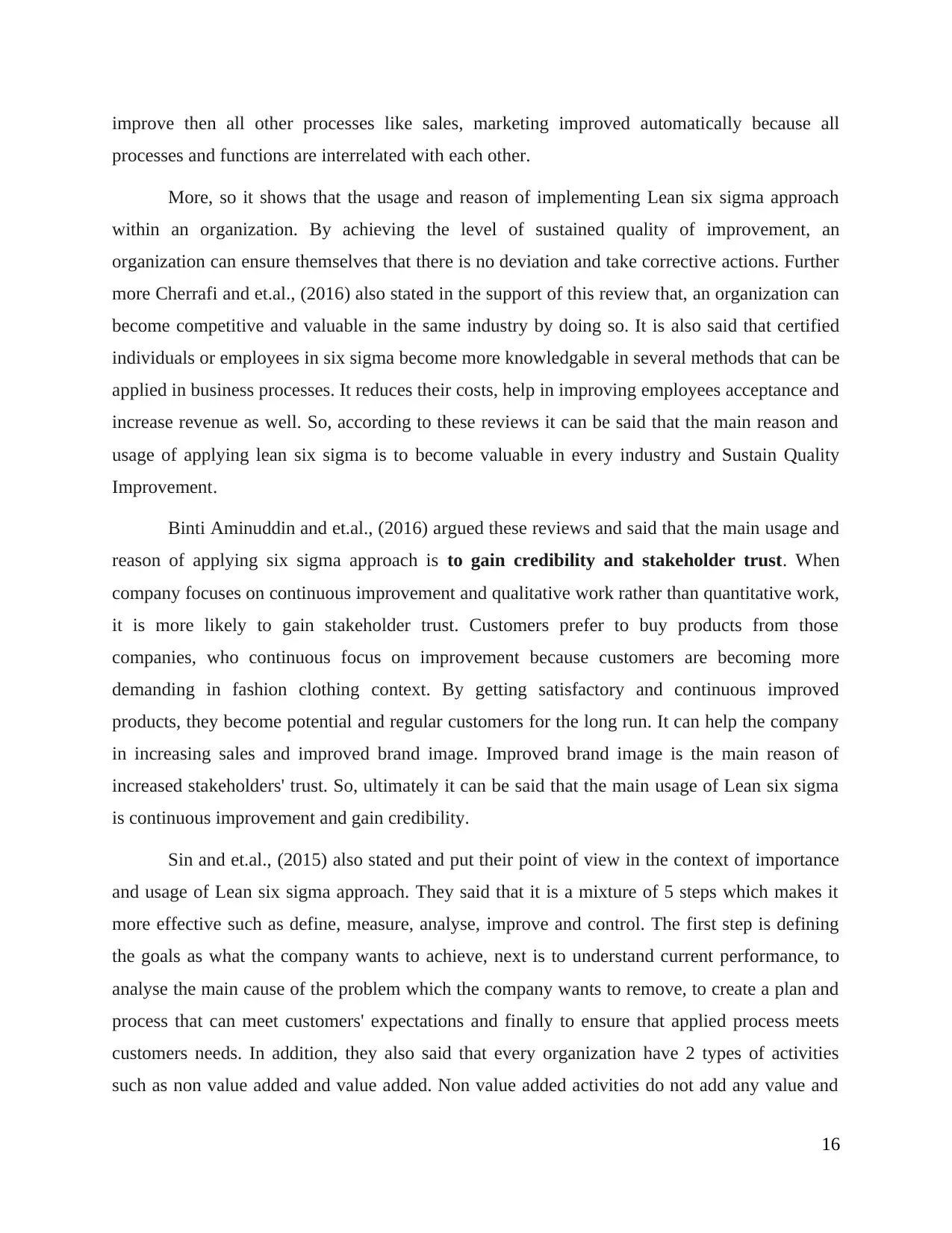
processes and functions are interrelated with each other.
More, so it shows that the usage and reason of implementing Lean six sigma approach
within an organization. By achieving the level of sustained quality of improvement, an
organization can ensure themselves that there is no deviation and take corrective actions. Further
more Cherrafi and et.al., (2016) also stated in the support of this review that, an organization can
become competitive and valuable in the same industry by doing so. It is also said that certified
individuals or employees in six sigma become more knowledgable in several methods that can be
applied in business processes. It reduces their costs, help in improving employees acceptance and
increase revenue as well. So, according to these reviews it can be said that the main reason and
usage of applying lean six sigma is to become valuable in every industry and Sustain Quality
Improvement.
Binti Aminuddin and et.al., (2016) argued these reviews and said that the main usage and
reason of applying six sigma approach is to gain credibility and stakeholder trust. When
company focuses on continuous improvement and qualitative work rather than quantitative work,
it is more likely to gain stakeholder trust. Customers prefer to buy products from those
companies, who continuous focus on improvement because customers are becoming more
demanding in fashion clothing context. By getting satisfactory and continuous improved
products, they become potential and regular customers for the long run. It can help the company
in increasing sales and improved brand image. Improved brand image is the main reason of
increased stakeholders' trust. So, ultimately it can be said that the main usage of Lean six sigma
is continuous improvement and gain credibility.
Sin and et.al., (2015) also stated and put their point of view in the context of importance
and usage of Lean six sigma approach. They said that it is a mixture of 5 steps which makes it
more effective such as define, measure, analyse, improve and control. The first step is defining
the goals as what the company wants to achieve, next is to understand current performance, to
analyse the main cause of the problem which the company wants to remove, to create a plan and
process that can meet customers' expectations and finally to ensure that applied process meets
customers needs. In addition, they also said that every organization have 2 types of activities
such as non value added and value added. Non value added activities do not add any value and
16
⊘ This is a preview!⊘
Do you want full access?
Subscribe today to unlock all pages.

Trusted by 1+ million students worldwide
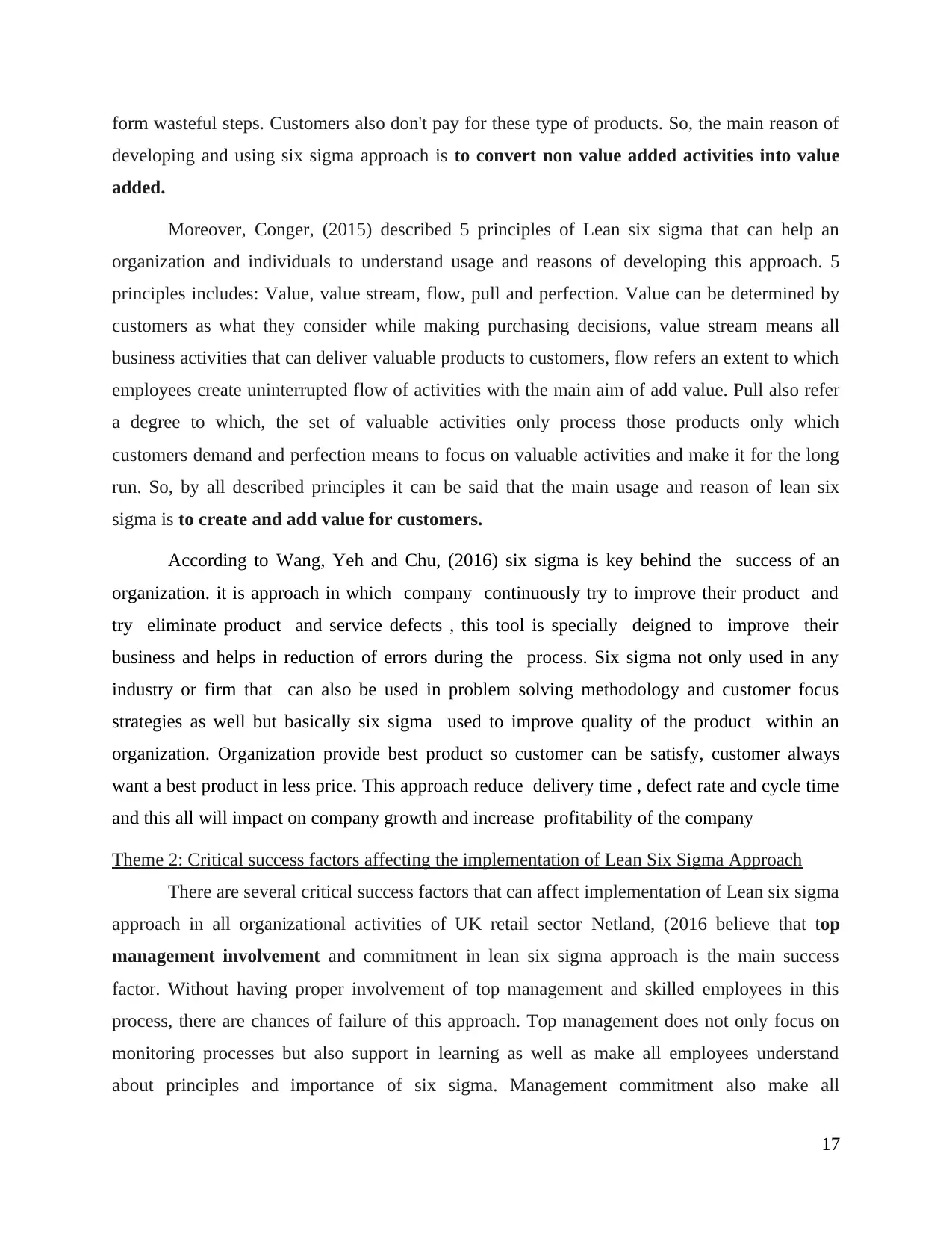
developing and using six sigma approach is to convert non value added activities into value
added.
Moreover, Conger, (2015) described 5 principles of Lean six sigma that can help an
organization and individuals to understand usage and reasons of developing this approach. 5
principles includes: Value, value stream, flow, pull and perfection. Value can be determined by
customers as what they consider while making purchasing decisions, value stream means all
business activities that can deliver valuable products to customers, flow refers an extent to which
employees create uninterrupted flow of activities with the main aim of add value. Pull also refer
a degree to which, the set of valuable activities only process those products only which
customers demand and perfection means to focus on valuable activities and make it for the long
run. So, by all described principles it can be said that the main usage and reason of lean six
sigma is to create and add value for customers.
According to Wang, Yeh and Chu, (2016) six sigma is key behind the success of an
organization. it is approach in which company continuously try to improve their product and
try eliminate product and service defects , this tool is specially deigned to improve their
business and helps in reduction of errors during the process. Six sigma not only used in any
industry or firm that can also be used in problem solving methodology and customer focus
strategies as well but basically six sigma used to improve quality of the product within an
organization. Organization provide best product so customer can be satisfy, customer always
want a best product in less price. This approach reduce delivery time , defect rate and cycle time
and this all will impact on company growth and increase profitability of the company
Theme 2: Critical success factors affecting the implementation of Lean Six Sigma Approach
There are several critical success factors that can affect implementation of Lean six sigma
approach in all organizational activities of UK retail sector Netland, (2016 believe that top
management involvement and commitment in lean six sigma approach is the main success
factor. Without having proper involvement of top management and skilled employees in this
process, there are chances of failure of this approach. Top management does not only focus on
monitoring processes but also support in learning as well as make all employees understand
about principles and importance of six sigma. Management commitment also make all
17
Paraphrase This Document
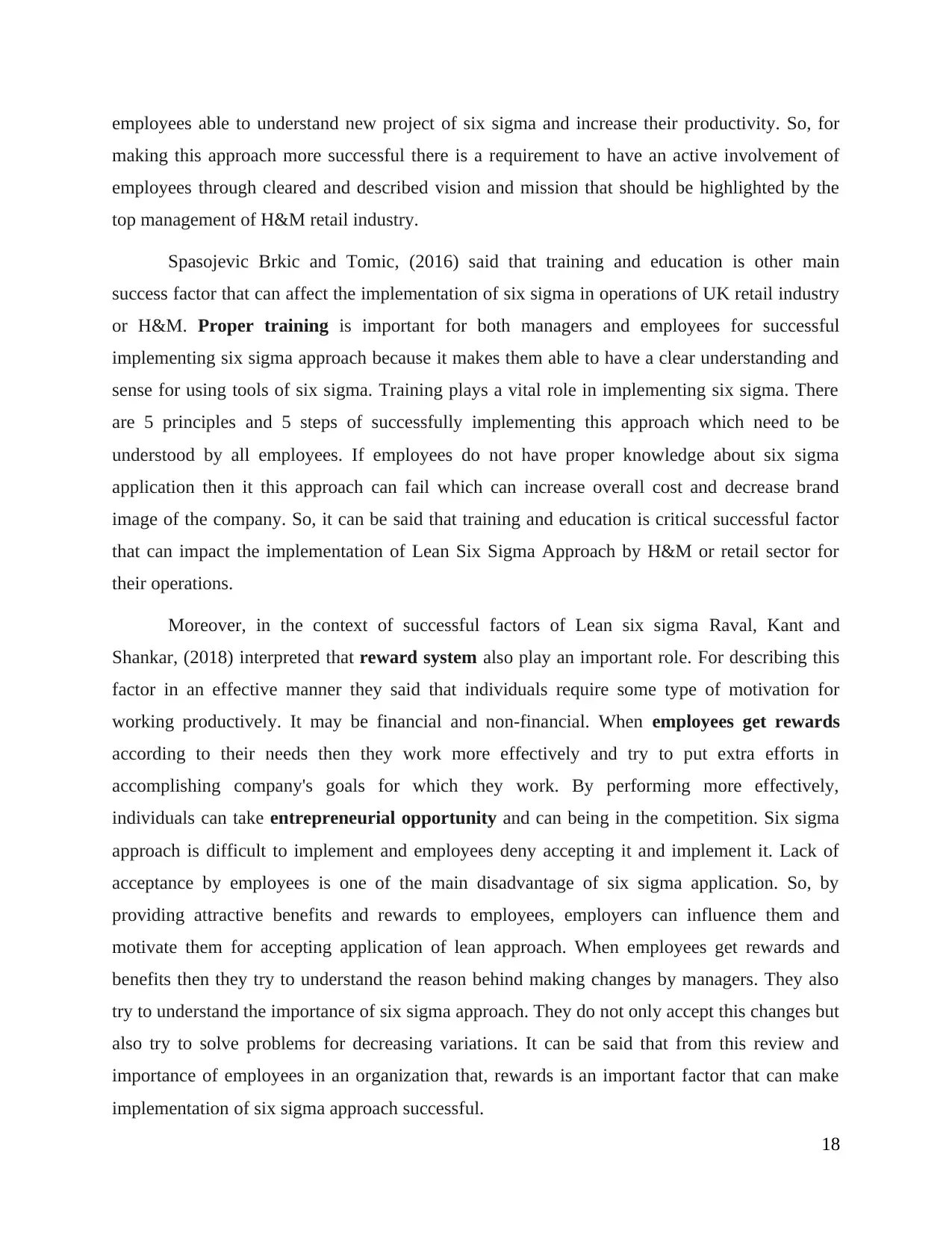
making this approach more successful there is a requirement to have an active involvement of
employees through cleared and described vision and mission that should be highlighted by the
top management of H&M retail industry.
Spasojevic Brkic and Tomic, (2016) said that training and education is other main
success factor that can affect the implementation of six sigma in operations of UK retail industry
or H&M. Proper training is important for both managers and employees for successful
implementing six sigma approach because it makes them able to have a clear understanding and
sense for using tools of six sigma. Training plays a vital role in implementing six sigma. There
are 5 principles and 5 steps of successfully implementing this approach which need to be
understood by all employees. If employees do not have proper knowledge about six sigma
application then it this approach can fail which can increase overall cost and decrease brand
image of the company. So, it can be said that training and education is critical successful factor
that can impact the implementation of Lean Six Sigma Approach by H&M or retail sector for
their operations.
Moreover, in the context of successful factors of Lean six sigma Raval, Kant and
Shankar, (2018) interpreted that reward system also play an important role. For describing this
factor in an effective manner they said that individuals require some type of motivation for
working productively. It may be financial and non-financial. When employees get rewards
according to their needs then they work more effectively and try to put extra efforts in
accomplishing company's goals for which they work. By performing more effectively,
individuals can take entrepreneurial opportunity and can being in the competition. Six sigma
approach is difficult to implement and employees deny accepting it and implement it. Lack of
acceptance by employees is one of the main disadvantage of six sigma application. So, by
providing attractive benefits and rewards to employees, employers can influence them and
motivate them for accepting application of lean approach. When employees get rewards and
benefits then they try to understand the reason behind making changes by managers. They also
try to understand the importance of six sigma approach. They do not only accept this changes but
also try to solve problems for decreasing variations. It can be said that from this review and
importance of employees in an organization that, rewards is an important factor that can make
implementation of six sigma approach successful.
18

plays an important role. There is no requirement to give benefits to employees, if they have
willingness to accept changes and implement Lean six sigma approach then they will definitely
accept it by hook or by crook. So, there is no need to give extra benefits because it can increase
overall cost of the company as well as time of manager. By recruiting skilled and experienced
employees within an organization, H&M can successfully implement Lean six sigma approach.
When employees have experience then they can solve any type of problem which occur at the
time of implementing this approach in manufacturing process. Along with experience and
human skills, team working and communication skills also play an important role that can have
effect on the implementation of Lean Six Sigma Approach on operations of H&M or retail
industry of UK. In other words it can also be said that selection of project team for implementing
this approach is the main successful factor. There are several organizations in retail sector and
other sector like Toyota who got success only by selecting a project leader. The selected project
leader should belong to the operational process. For instance, by appointing a skilled and
experience member of HR team in order to lead a project, an organization can bring positive and
drastic improvements to a finance process.
For more supporting this view and in the context of successful factors that lead a success
in implementation of Lean six sigma Moullin, (2017) said that monitoring and evaluation of
the whole performance play a significant role. They said that without proper monitoring and
evaluation of the performance, manager can not make growth. Lack of monitoring functions can
lead errors in the whole performance. It can increase the work pressure, time and cost of the
company. It is stated already that lack of employees acceptance is the main disadvantage. They
accept it rarely and when they accept it that time they seek success of this project. When they
become fail in implementing this approach in manufacturing process then they become frustrated
and show anger. It can lead absenteeism from the organization which is not good for employees
and the company. By monitoring and evaluation of the process and performance of this
approach, manager can make sure that all employees are doing as per the training and guidance.
The main aim of monitoring and evaluation is to make the process errorless and effective. By
doing this they can make implementation successful and increase trust among all its employees
as well as its stakeholders. So, it is important for H&M to focus on monitoring and evaluation of
the performance.
19
⊘ This is a preview!⊘
Do you want full access?
Subscribe today to unlock all pages.

Trusted by 1+ million students worldwide
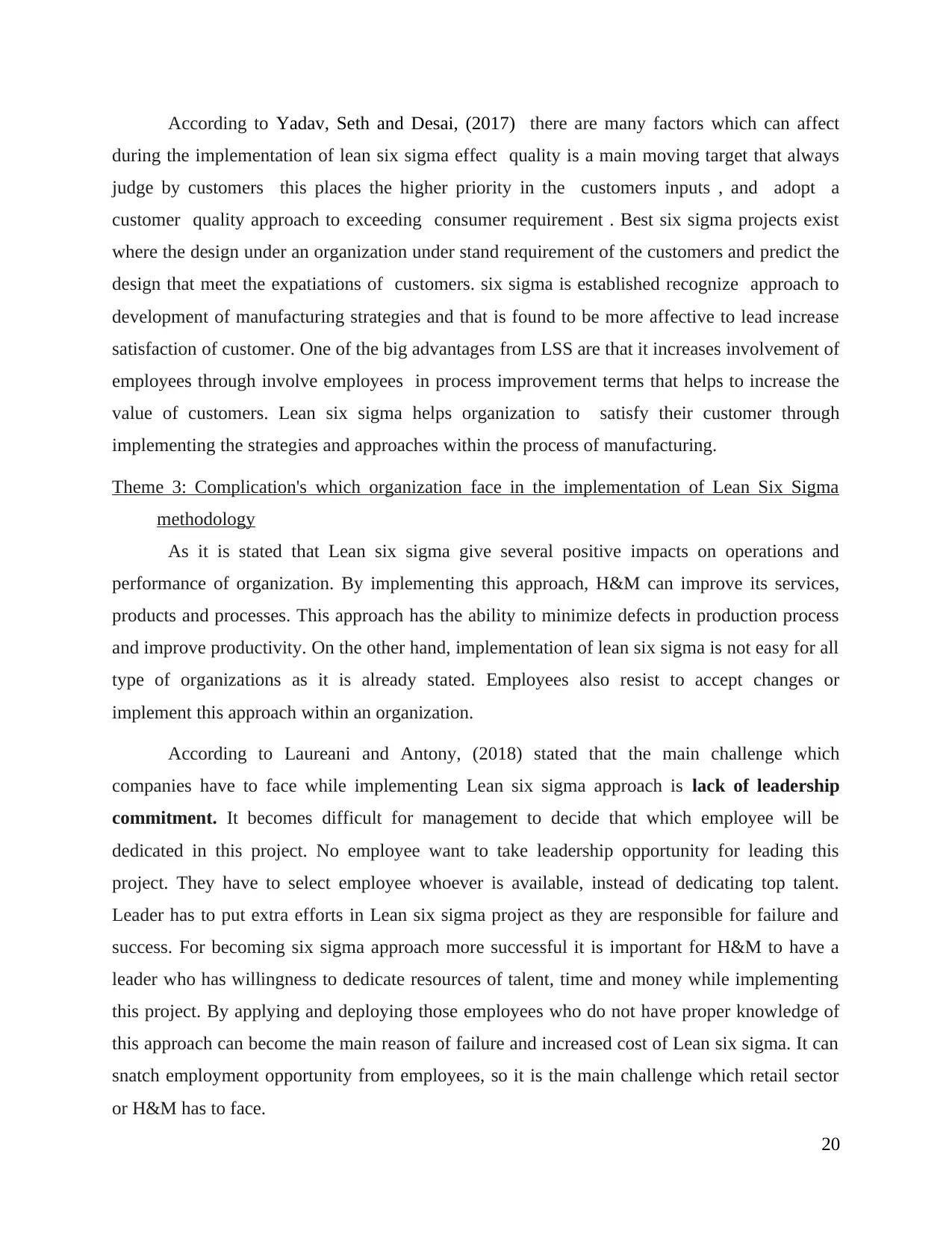
during the implementation of lean six sigma effect quality is a main moving target that always
judge by customers this places the higher priority in the customers inputs , and adopt a
customer quality approach to exceeding consumer requirement . Best six sigma projects exist
where the design under an organization under stand requirement of the customers and predict the
design that meet the expatiations of customers. six sigma is established recognize approach to
development of manufacturing strategies and that is found to be more affective to lead increase
satisfaction of customer. One of the big advantages from LSS are that it increases involvement of
employees through involve employees in process improvement terms that helps to increase the
value of customers. Lean six sigma helps organization to satisfy their customer through
implementing the strategies and approaches within the process of manufacturing.
Theme 3: Complication's which organization face in the implementation of Lean Six Sigma
methodology
As it is stated that Lean six sigma give several positive impacts on operations and
performance of organization. By implementing this approach, H&M can improve its services,
products and processes. This approach has the ability to minimize defects in production process
and improve productivity. On the other hand, implementation of lean six sigma is not easy for all
type of organizations as it is already stated. Employees also resist to accept changes or
implement this approach within an organization.
According to Laureani and Antony, (2018) stated that the main challenge which
companies have to face while implementing Lean six sigma approach is lack of leadership
commitment. It becomes difficult for management to decide that which employee will be
dedicated in this project. No employee want to take leadership opportunity for leading this
project. They have to select employee whoever is available, instead of dedicating top talent.
Leader has to put extra efforts in Lean six sigma project as they are responsible for failure and
success. For becoming six sigma approach more successful it is important for H&M to have a
leader who has willingness to dedicate resources of talent, time and money while implementing
this project. By applying and deploying those employees who do not have proper knowledge of
this approach can become the main reason of failure and increased cost of Lean six sigma. It can
snatch employment opportunity from employees, so it is the main challenge which retail sector
or H&M has to face.
20
Paraphrase This Document

six sigma approach is the main challenge and reason of failure of six sigma approach. Lack of
proper or inappropriate knowledge of Lean six sigma approach can create several problems at the
time of implementing this in manufacturing process. The main aim of this approach is to reduce
wastes and increase efficiency but incomplete understanding can increase their cost because
implementing six sigma requires several resources. Some employees do not want to learn some
principles and rules of six sigma before applying them due to resistance to change. In some
cases, employees have loss of job fear if six sigma is applied. But the main aim of six sigma is to
reduce defects not to eliminate jobs. They also state that statistical tools are cumbersome to
learn, so they delay in implementing this approach knowingly in order to show the manager that
six sigma is just a fade and there is no benefit to implement this.
In addition, it is also stated Antony, Rodgers and Cudney, 2019) that some individuals
and companies think that this approach is only for large manufacturing companies and not for
small and medium companies, so employers as well as employees of small and medium size
company resist to implementation of this approach. Due to this resistance and failure of other
operations of company, it can snatch employment opportunity from them. Some time
stakeholders also resist the change stating that six sigma is complex and failure of this approach
can decrease their profits. So, it can be said that resistance regarding this approach vary from
organization to organization as it also depends on the size of the company. Lean six sigma
focuses on value by eliminating wastes and acceleration in the velocity of processes. Most of the
employees are front line operators and six sigma involves an advanced mathematics and statistics
which put pressure on them to learn these things. Sometimes it depresses them which leads
absenteeism from the company. So, according to these views it can be said that incomplete
understanding and resistance is the main factor and challenges which h&m may have to face
while implementing this approach within its business.
The other main challenges which companies have to face at the time of implementing
Lean six sigma approach with the main aim of reducing wastes and increase' customers
experience is supply chain issue. The first and preliminary aim of this approach is to eliminate
storage time by incoming and delivering only required products at the required time. For making
this effective there is a remitment for the company to adopt other approach like just in time. Just
in time makes sure about delivery of products on the time. Manager requires coordinating with
21

workload and management activities. This kind of close coordination sometimes create host
issues for the company because project manager of the company have to coordinate with both
approaches and processes while managing their own side of implementation project. For
managing supply chain issues, they also required an effective technological infrastructure. For
implementing this approach, skilled and well-educated employees are required and due to
external factors like unemployment and employment rate can create the problem in recruiting
skilled workforce Yaduvanshi and Sharma, (2017).
It is also stated Antony, Vinodh and Gijo, 2016) in the context of challenges which
companies have to face at the time of implementing Lean six sigma approach for reducing
wastes and increasing productivity is technological issue. Technological and cultural issues also
create some problems at the time of implementing and developing lean six sigma approach
within an organization. There is a requirement for the company to invest in statistical analysis
software for monitoring quality improvement and for becoming sure that all processes are being
done in an effective manner by employees. Choosing the right tool is system is the main part in
the process of manufacturing and implementation of six sigma approach. For taking an effective
decision regarding selecting the tool and making plan for this, consume time of the company. It
hampers their other activities and management. Due to mismanagement and consuming time
may delay other activities. Delay in providing services to customers can decrease sales and
customers satisfaction as well.
According to Yeakley and et.al., (2016) most of the manufacturers are successful after
using lean sigma and they rise productivity and increase quality and customer experience but
some of them still not discover any value in lean six sigma . This approach only focus to
eliminate waste from manufacturing and boost the process velocity. Commonly manufacturers
do not apply this because they never heard about this approach and many of them don't have time
to apply. This approach is more costly and small companies can not afford. Lean sigma involves
many strategies and advance level of mathematics employees are efficient to use those strategies
most of them are just a line operators it is not easy task for them to understand mathematics of
this approach. Many companies denied for lean manufacturing because they think that they are
small and this approach is only for large companies they are having fear of failure. Organizations
use this from many year but they did not receive any result this problem faced by many
22
⊘ This is a preview!⊘
Do you want full access?
Subscribe today to unlock all pages.

Trusted by 1+ million students worldwide
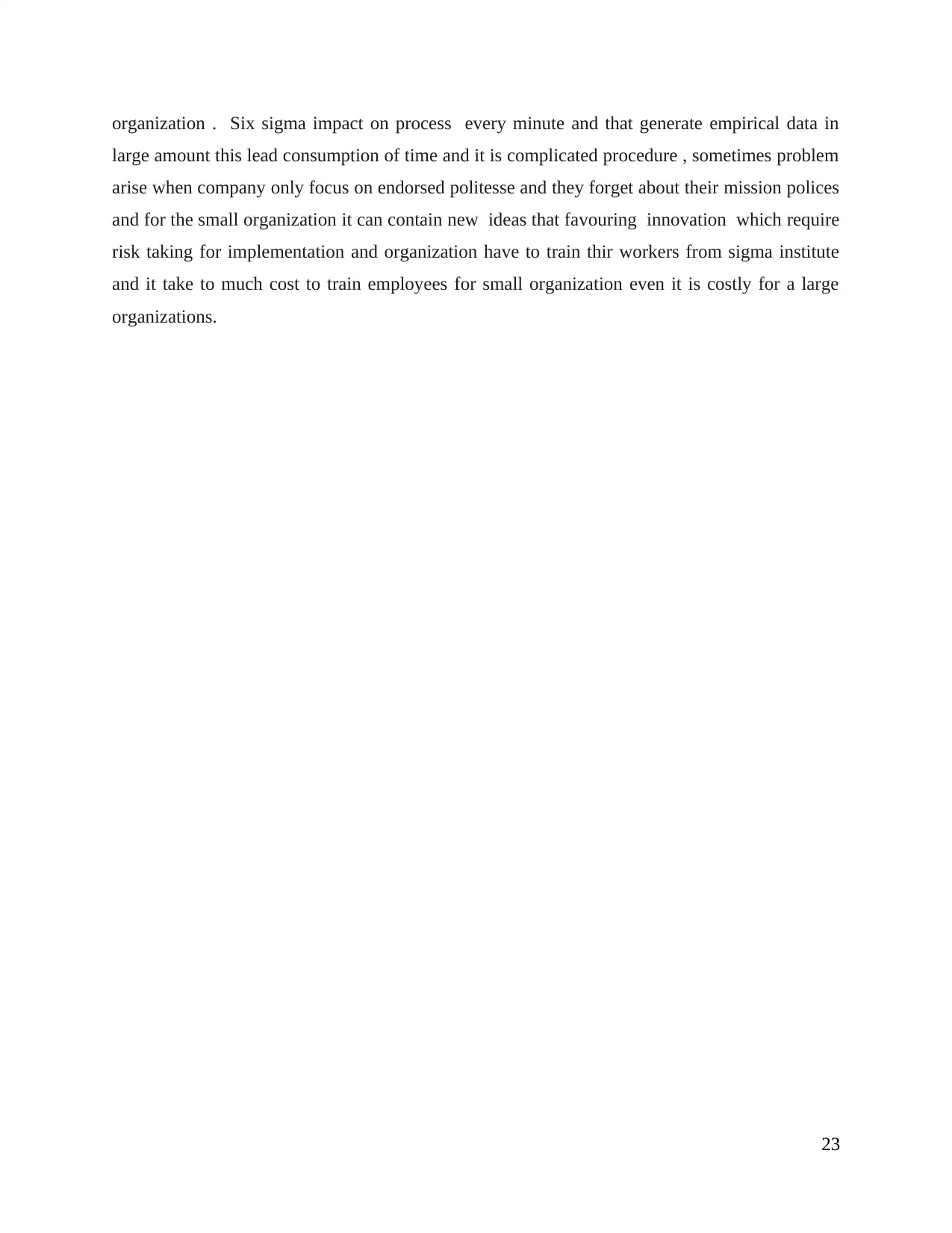
large amount this lead consumption of time and it is complicated procedure , sometimes problem
arise when company only focus on endorsed politesse and they forget about their mission polices
and for the small organization it can contain new ideas that favouring innovation which require
risk taking for implementation and organization have to train thir workers from sigma institute
and it take to much cost to train employees for small organization even it is costly for a large
organizations.
23
Paraphrase This Document
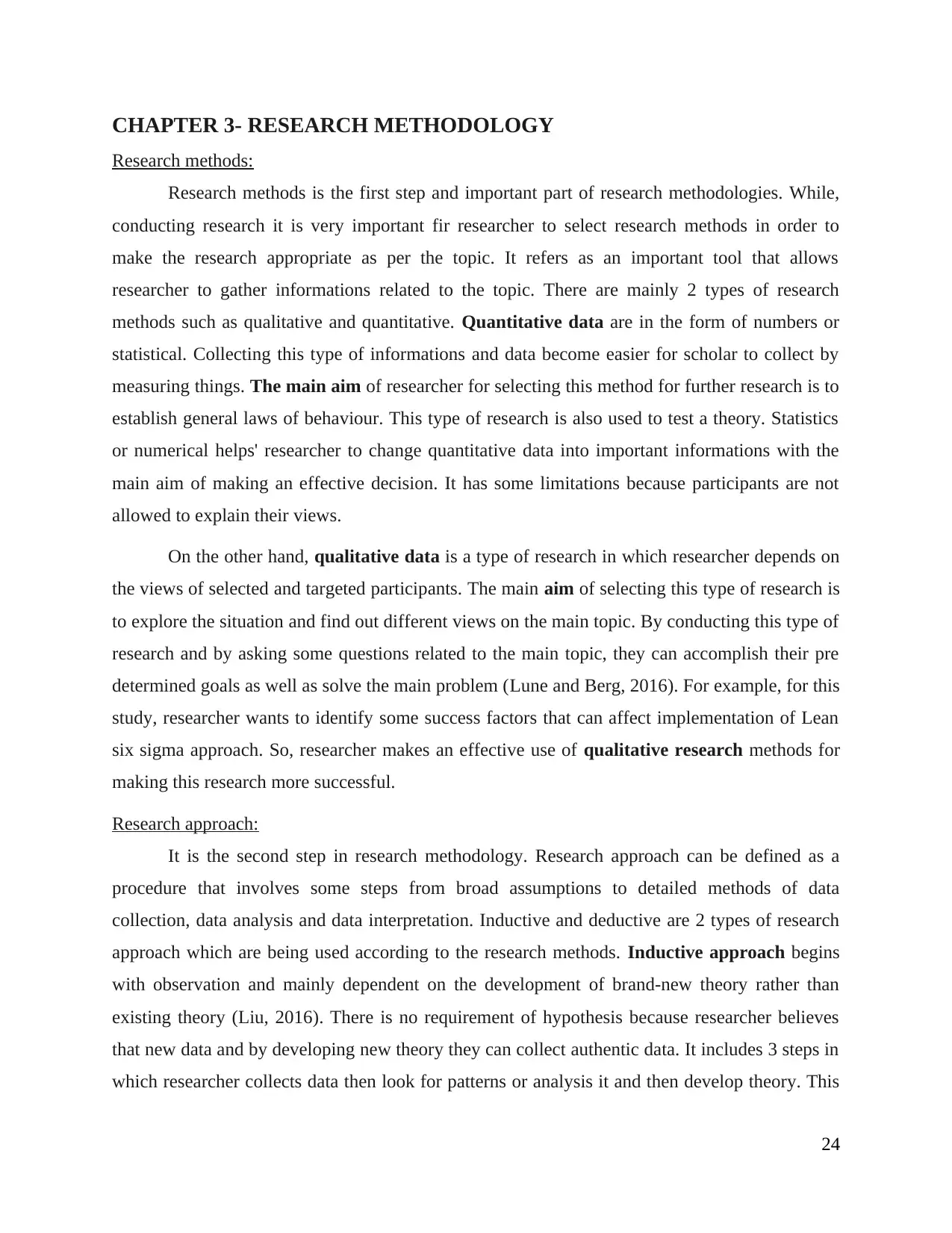
Research methods:
Research methods is the first step and important part of research methodologies. While,
conducting research it is very important fir researcher to select research methods in order to
make the research appropriate as per the topic. It refers as an important tool that allows
researcher to gather informations related to the topic. There are mainly 2 types of research
methods such as qualitative and quantitative. Quantitative data are in the form of numbers or
statistical. Collecting this type of informations and data become easier for scholar to collect by
measuring things. The main aim of researcher for selecting this method for further research is to
establish general laws of behaviour. This type of research is also used to test a theory. Statistics
or numerical helps' researcher to change quantitative data into important informations with the
main aim of making an effective decision. It has some limitations because participants are not
allowed to explain their views.
On the other hand, qualitative data is a type of research in which researcher depends on
the views of selected and targeted participants. The main aim of selecting this type of research is
to explore the situation and find out different views on the main topic. By conducting this type of
research and by asking some questions related to the main topic, they can accomplish their pre
determined goals as well as solve the main problem (Lune and Berg, 2016). For example, for this
study, researcher wants to identify some success factors that can affect implementation of Lean
six sigma approach. So, researcher makes an effective use of qualitative research methods for
making this research more successful.
Research approach:
It is the second step in research methodology. Research approach can be defined as a
procedure that involves some steps from broad assumptions to detailed methods of data
collection, data analysis and data interpretation. Inductive and deductive are 2 types of research
approach which are being used according to the research methods. Inductive approach begins
with observation and mainly dependent on the development of brand-new theory rather than
existing theory (Liu, 2016). There is no requirement of hypothesis because researcher believes
that new data and by developing new theory they can collect authentic data. It includes 3 steps in
which researcher collects data then look for patterns or analysis it and then develop theory. This
24
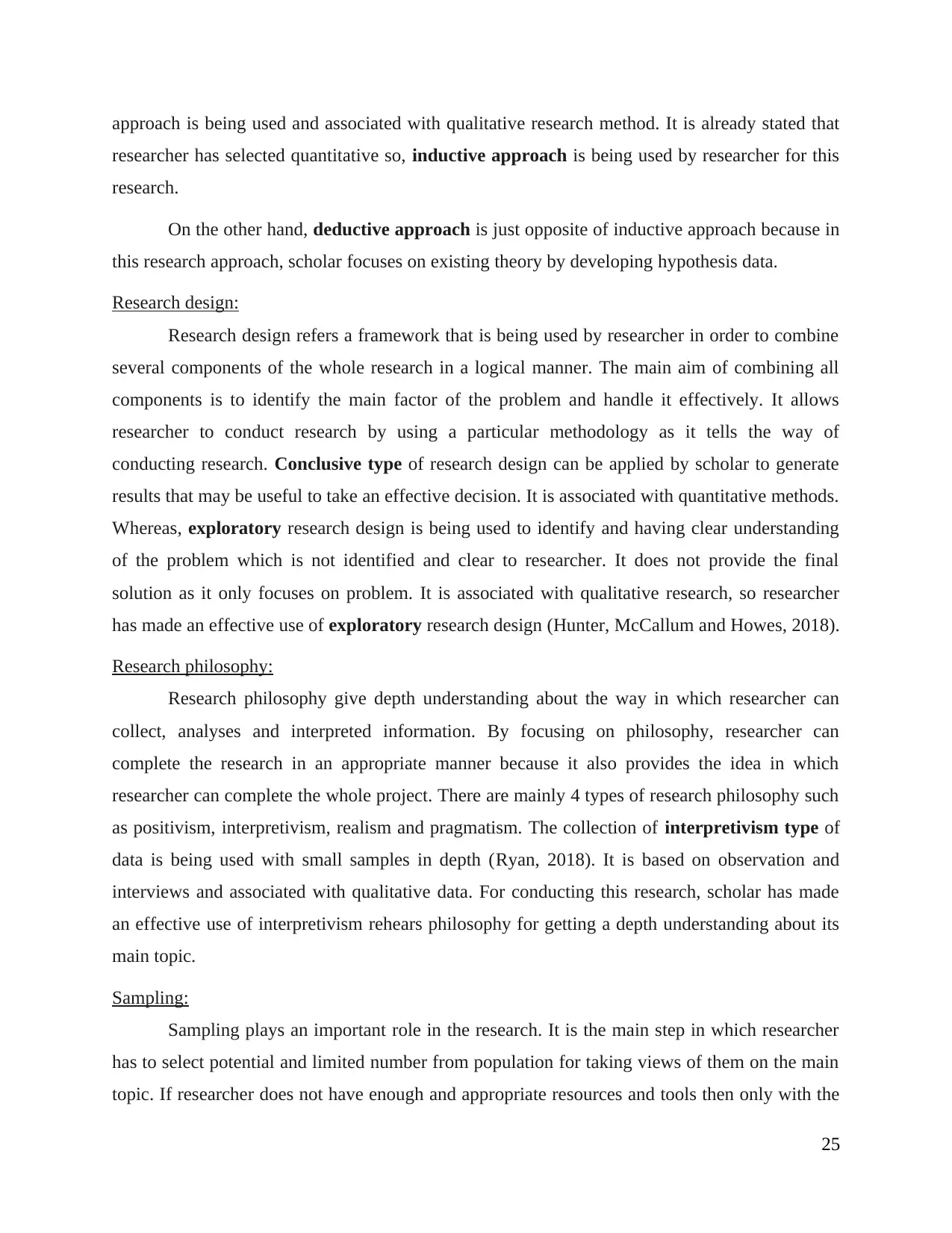
researcher has selected quantitative so, inductive approach is being used by researcher for this
research.
On the other hand, deductive approach is just opposite of inductive approach because in
this research approach, scholar focuses on existing theory by developing hypothesis data.
Research design:
Research design refers a framework that is being used by researcher in order to combine
several components of the whole research in a logical manner. The main aim of combining all
components is to identify the main factor of the problem and handle it effectively. It allows
researcher to conduct research by using a particular methodology as it tells the way of
conducting research. Conclusive type of research design can be applied by scholar to generate
results that may be useful to take an effective decision. It is associated with quantitative methods.
Whereas, exploratory research design is being used to identify and having clear understanding
of the problem which is not identified and clear to researcher. It does not provide the final
solution as it only focuses on problem. It is associated with qualitative research, so researcher
has made an effective use of exploratory research design (Hunter, McCallum and Howes, 2018).
Research philosophy:
Research philosophy give depth understanding about the way in which researcher can
collect, analyses and interpreted information. By focusing on philosophy, researcher can
complete the research in an appropriate manner because it also provides the idea in which
researcher can complete the whole project. There are mainly 4 types of research philosophy such
as positivism, interpretivism, realism and pragmatism. The collection of interpretivism type of
data is being used with small samples in depth (Ryan, 2018). It is based on observation and
interviews and associated with qualitative data. For conducting this research, scholar has made
an effective use of interpretivism rehears philosophy for getting a depth understanding about its
main topic.
Sampling:
Sampling plays an important role in the research. It is the main step in which researcher
has to select potential and limited number from population for taking views of them on the main
topic. If researcher does not have enough and appropriate resources and tools then only with the
25
⊘ This is a preview!⊘
Do you want full access?
Subscribe today to unlock all pages.

Trusted by 1+ million students worldwide
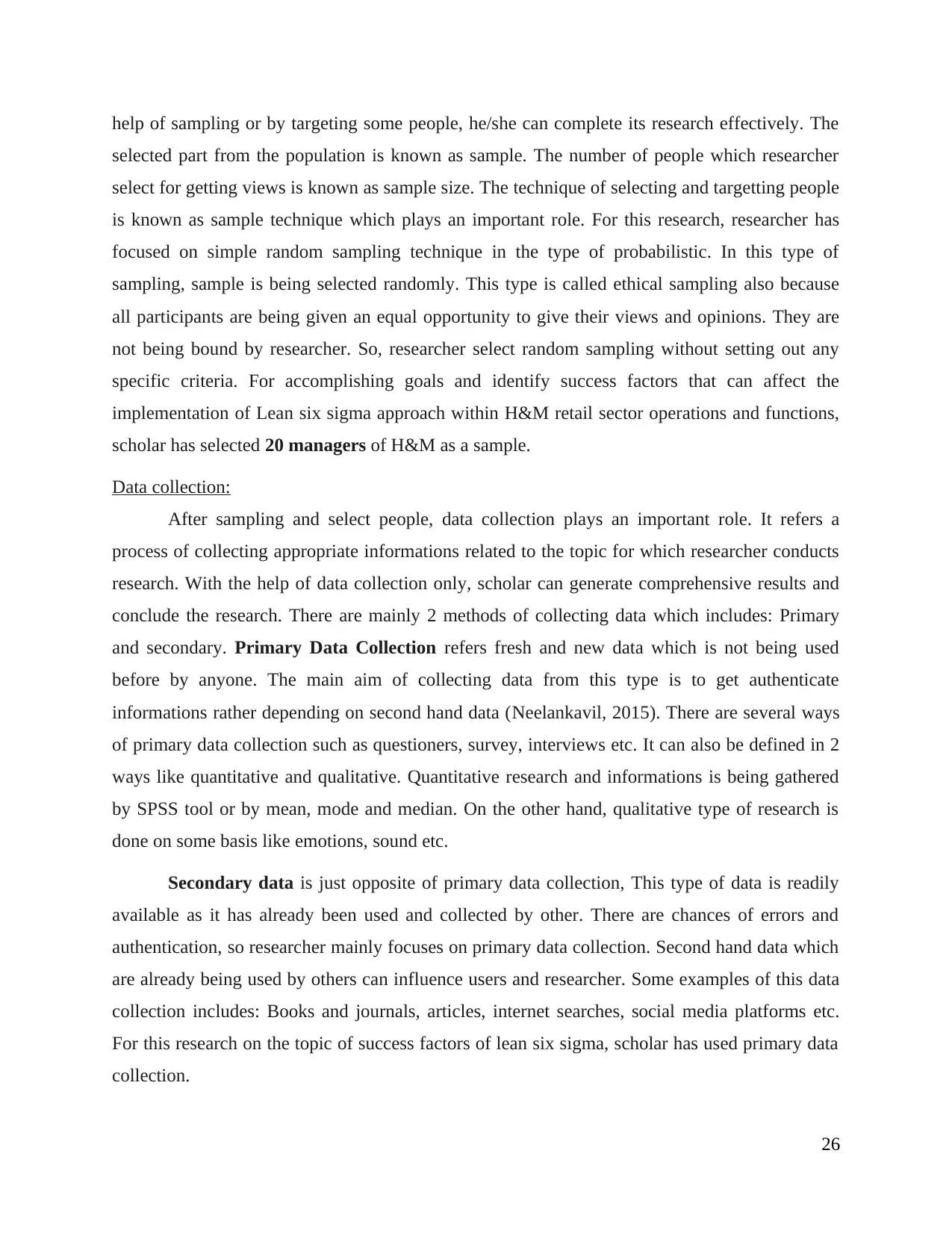
selected part from the population is known as sample. The number of people which researcher
select for getting views is known as sample size. The technique of selecting and targetting people
is known as sample technique which plays an important role. For this research, researcher has
focused on simple random sampling technique in the type of probabilistic. In this type of
sampling, sample is being selected randomly. This type is called ethical sampling also because
all participants are being given an equal opportunity to give their views and opinions. They are
not being bound by researcher. So, researcher select random sampling without setting out any
specific criteria. For accomplishing goals and identify success factors that can affect the
implementation of Lean six sigma approach within H&M retail sector operations and functions,
scholar has selected 20 managers of H&M as a sample.
Data collection:
After sampling and select people, data collection plays an important role. It refers a
process of collecting appropriate informations related to the topic for which researcher conducts
research. With the help of data collection only, scholar can generate comprehensive results and
conclude the research. There are mainly 2 methods of collecting data which includes: Primary
and secondary. Primary Data Collection refers fresh and new data which is not being used
before by anyone. The main aim of collecting data from this type is to get authenticate
informations rather depending on second hand data (Neelankavil, 2015). There are several ways
of primary data collection such as questioners, survey, interviews etc. It can also be defined in 2
ways like quantitative and qualitative. Quantitative research and informations is being gathered
by SPSS tool or by mean, mode and median. On the other hand, qualitative type of research is
done on some basis like emotions, sound etc.
Secondary data is just opposite of primary data collection, This type of data is readily
available as it has already been used and collected by other. There are chances of errors and
authentication, so researcher mainly focuses on primary data collection. Second hand data which
are already being used by others can influence users and researcher. Some examples of this data
collection includes: Books and journals, articles, internet searches, social media platforms etc.
For this research on the topic of success factors of lean six sigma, scholar has used primary data
collection.
26
Paraphrase This Document
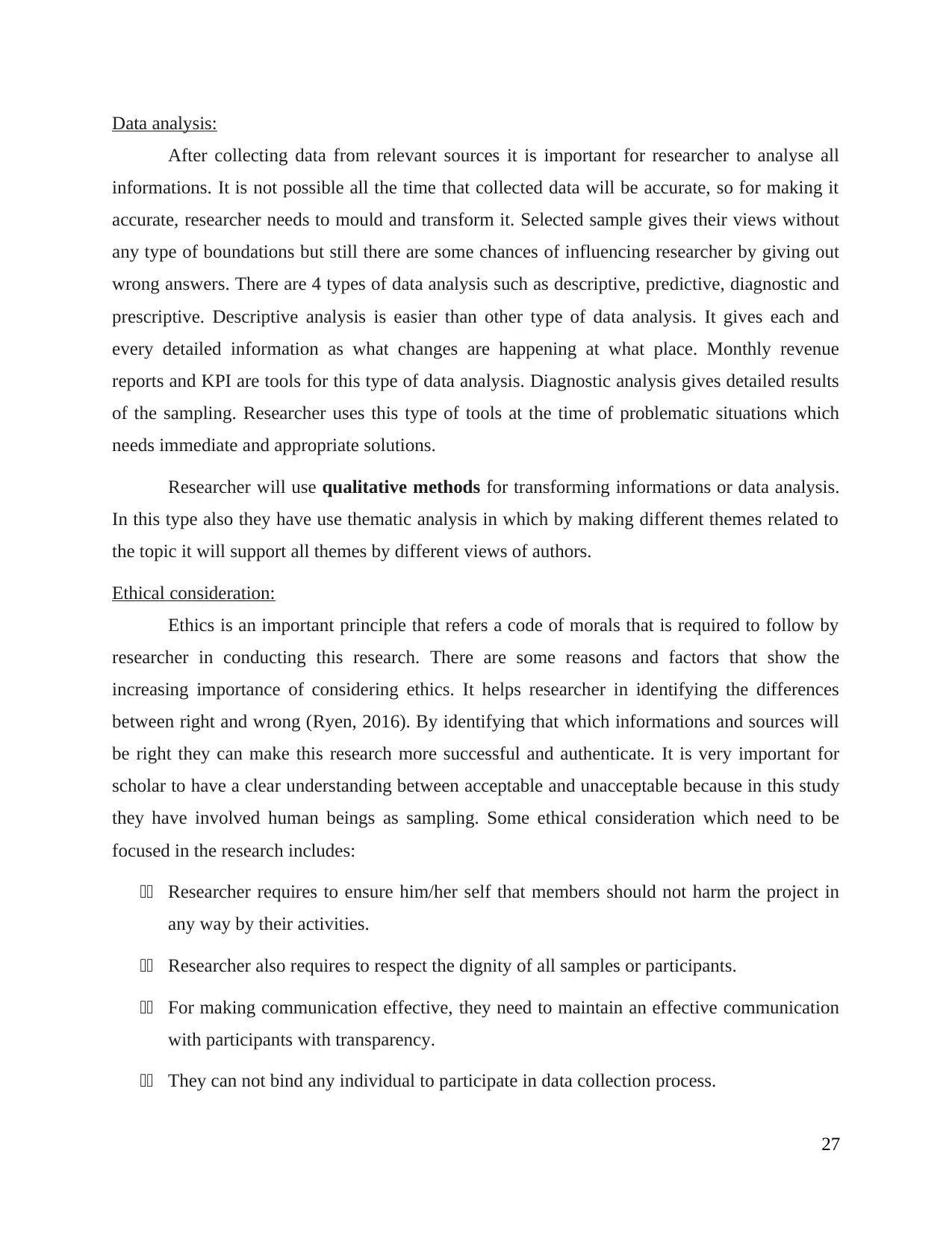
After collecting data from relevant sources it is important for researcher to analyse all
informations. It is not possible all the time that collected data will be accurate, so for making it
accurate, researcher needs to mould and transform it. Selected sample gives their views without
any type of boundations but still there are some chances of influencing researcher by giving out
wrong answers. There are 4 types of data analysis such as descriptive, predictive, diagnostic and
prescriptive. Descriptive analysis is easier than other type of data analysis. It gives each and
every detailed information as what changes are happening at what place. Monthly revenue
reports and KPI are tools for this type of data analysis. Diagnostic analysis gives detailed results
of the sampling. Researcher uses this type of tools at the time of problematic situations which
needs immediate and appropriate solutions.
Researcher will use qualitative methods for transforming informations or data analysis.
In this type also they have use thematic analysis in which by making different themes related to
the topic it will support all themes by different views of authors.
Ethical consideration:
Ethics is an important principle that refers a code of morals that is required to follow by
researcher in conducting this research. There are some reasons and factors that show the
increasing importance of considering ethics. It helps researcher in identifying the differences
between right and wrong (Ryen, 2016). By identifying that which informations and sources will
be right they can make this research more successful and authenticate. It is very important for
scholar to have a clear understanding between acceptable and unacceptable because in this study
they have involved human beings as sampling. Some ethical consideration which need to be
focused in the research includes:
11 Researcher requires to ensure him/her self that members should not harm the project in
any way by their activities.
11 Researcher also requires to respect the dignity of all samples or participants.
11 For making communication effective, they need to maintain an effective communication
with participants with transparency.
11 They can not bind any individual to participate in data collection process.
27

misbehave towards this.
111 There is also requirement to keep all personal and private informations safe like address,
name and answers given by participants.
28
⊘ This is a preview!⊘
Do you want full access?
Subscribe today to unlock all pages.

Trusted by 1+ million students worldwide
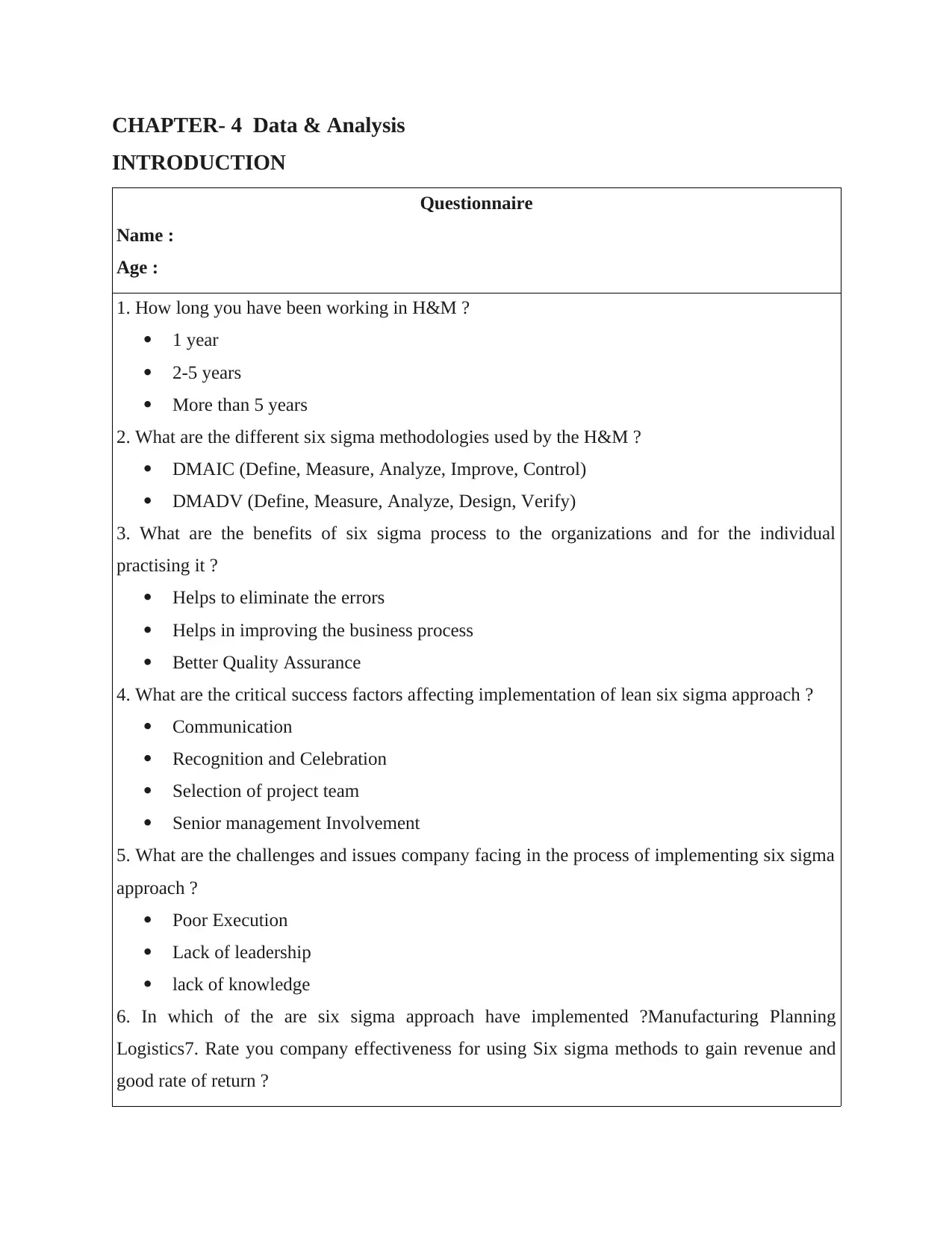
INTRODUCTION
Questionnaire
Name :
Age :
1. How long you have been working in H&M ?
1 year
2-5 years
More than 5 years
2. What are the different six sigma methodologies used by the H&M ?
DMAIC (Define, Measure, Analyze, Improve, Control)
DMADV (Define, Measure, Analyze, Design, Verify)
3. What are the benefits of six sigma process to the organizations and for the individual
practising it ?
Helps to eliminate the errors
Helps in improving the business process
Better Quality Assurance
4. What are the critical success factors affecting implementation of lean six sigma approach ?
Communication
Recognition and Celebration
Selection of project team
Senior management Involvement
5. What are the challenges and issues company facing in the process of implementing six sigma
approach ?
Poor Execution
Lack of leadership
lack of knowledge
6. In which of the are six sigma approach have implemented ?Manufacturing Planning
Logistics7. Rate you company effectiveness for using Six sigma methods to gain revenue and
good rate of return ?
Paraphrase This Document
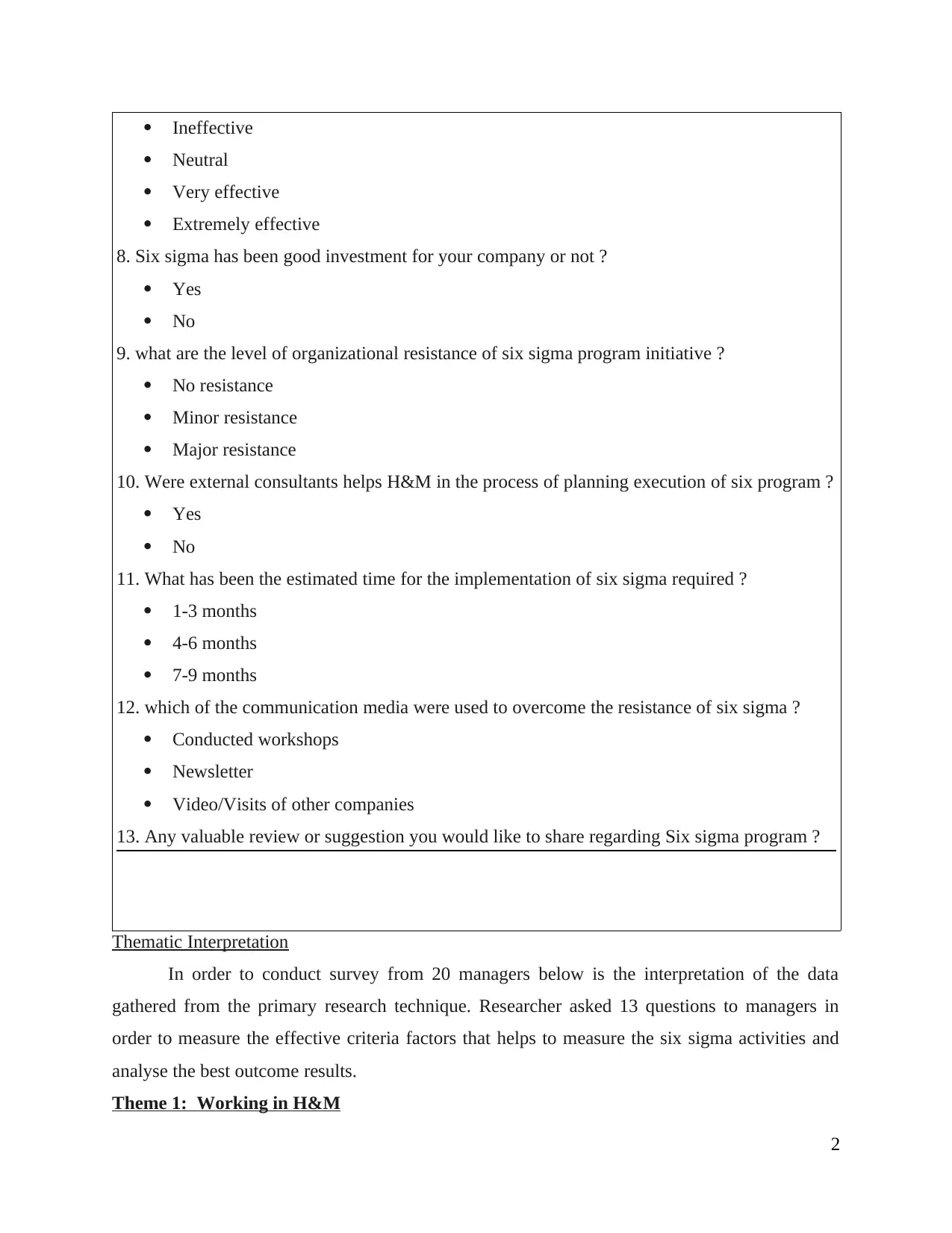
Neutral
Very effective
Extremely effective
8. Six sigma has been good investment for your company or not ?
Yes
No
9. what are the level of organizational resistance of six sigma program initiative ?
No resistance
Minor resistance
Major resistance
10. Were external consultants helps H&M in the process of planning execution of six program ?
Yes
No
11. What has been the estimated time for the implementation of six sigma required ?
1-3 months
4-6 months
7-9 months
12. which of the communication media were used to overcome the resistance of six sigma ?
Conducted workshops
Newsletter
Video/Visits of other companies
13. Any valuable review or suggestion you would like to share regarding Six sigma program ?
Thematic Interpretation
In order to conduct survey from 20 managers below is the interpretation of the data
gathered from the primary research technique. Researcher asked 13 questions to managers in
order to measure the effective criteria factors that helps to measure the six sigma activities and
analyse the best outcome results.
Theme 1: Working in H&M
2
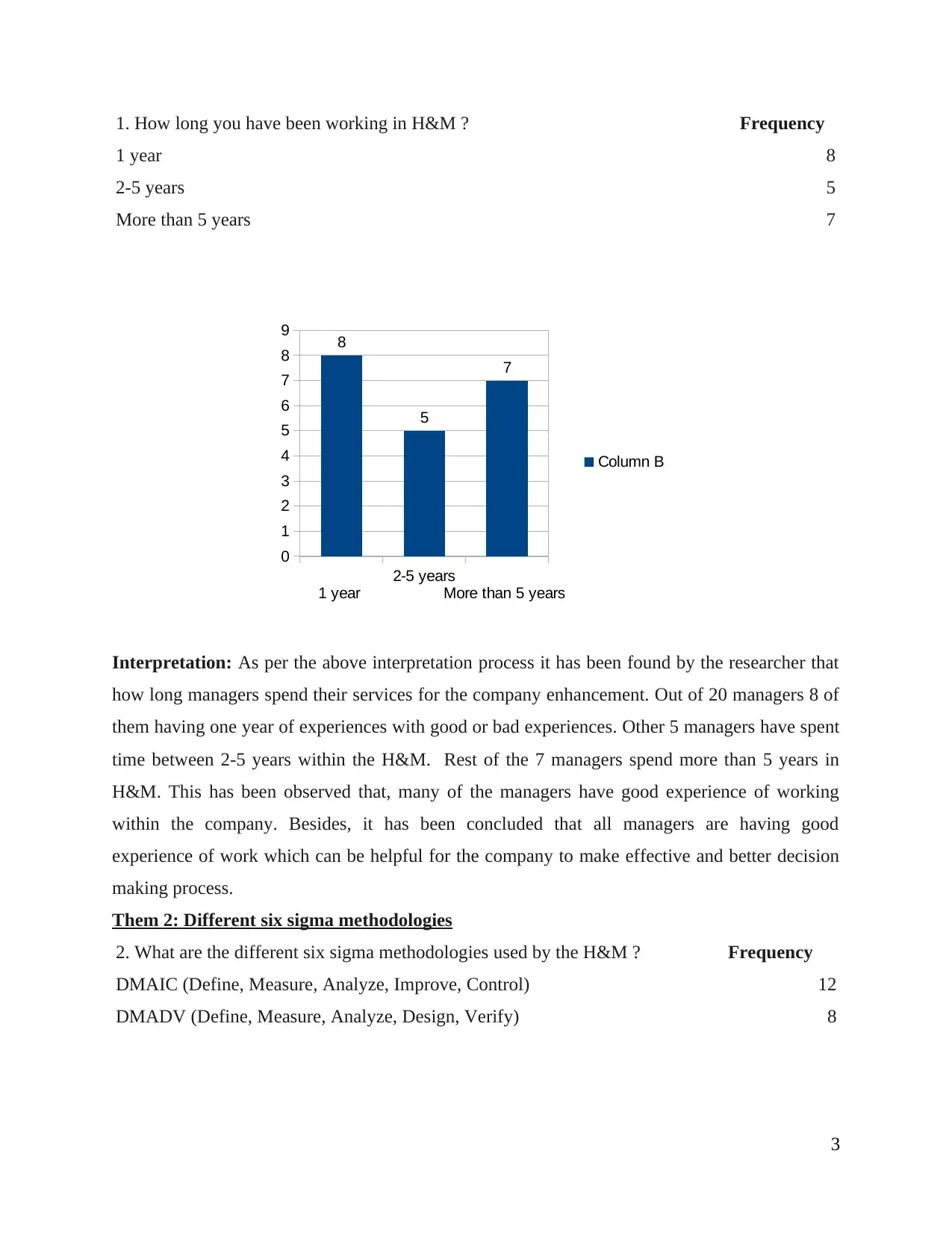
1 year 8
2-5 years 5
More than 5 years 7
Interpretation: As per the above interpretation process it has been found by the researcher that
how long managers spend their services for the company enhancement. Out of 20 managers 8 of
them having one year of experiences with good or bad experiences. Other 5 managers have spent
time between 2-5 years within the H&M. Rest of the 7 managers spend more than 5 years in
H&M. This has been observed that, many of the managers have good experience of working
within the company. Besides, it has been concluded that all managers are having good
experience of work which can be helpful for the company to make effective and better decision
making process.
Them 2: Different six sigma methodologies
2. What are the different six sigma methodologies used by the H&M ? Frequency
DMAIC (Define, Measure, Analyze, Improve, Control) 12
DMADV (Define, Measure, Analyze, Design, Verify) 8
3
1 year
2-5 years
More than 5 years
0
1
2
3
4
5
6
7
8
9 8
5
7
Column B
⊘ This is a preview!⊘
Do you want full access?
Subscribe today to unlock all pages.

Trusted by 1+ million students worldwide
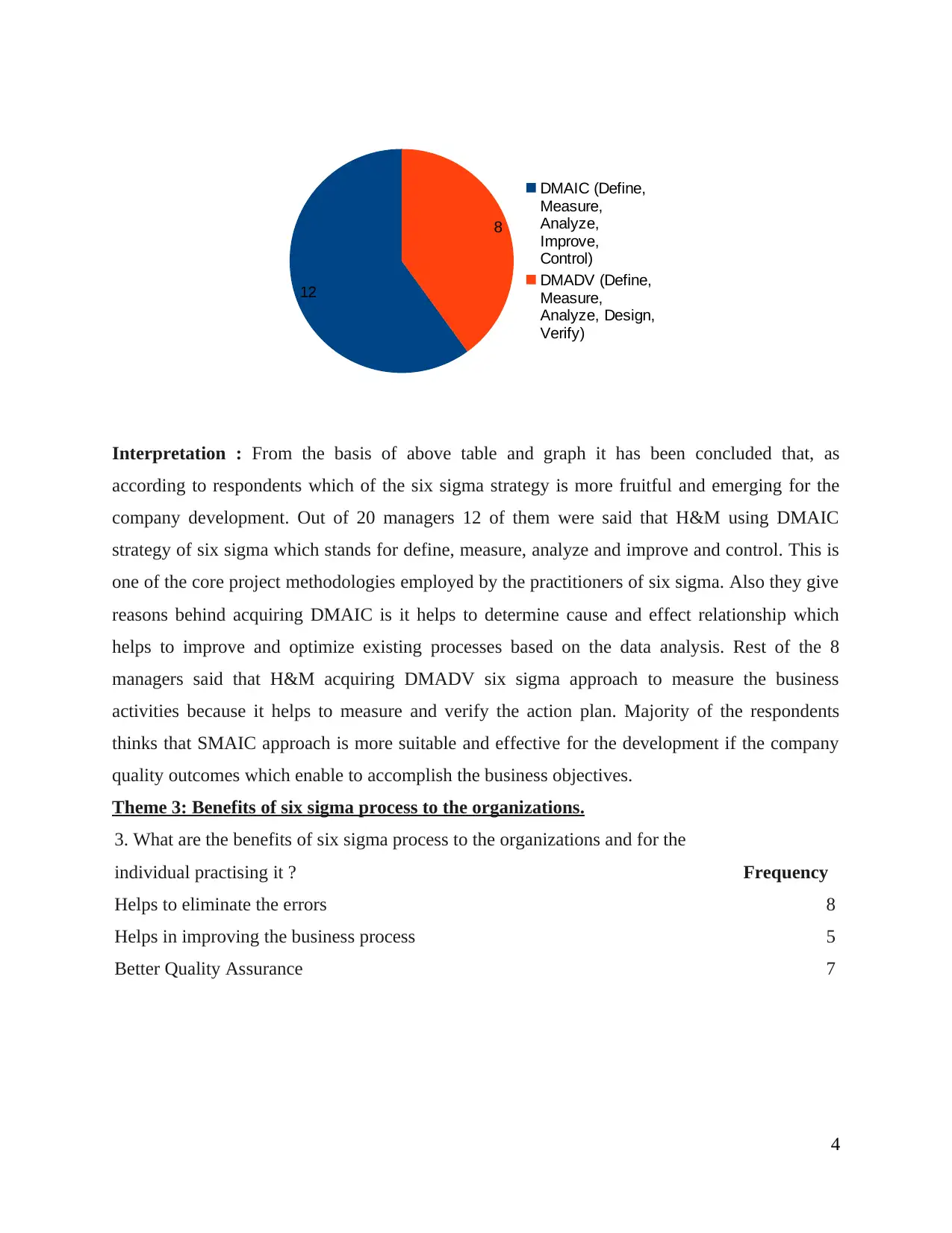
according to respondents which of the six sigma strategy is more fruitful and emerging for the
company development. Out of 20 managers 12 of them were said that H&M using DMAIC
strategy of six sigma which stands for define, measure, analyze and improve and control. This is
one of the core project methodologies employed by the practitioners of six sigma. Also they give
reasons behind acquiring DMAIC is it helps to determine cause and effect relationship which
helps to improve and optimize existing processes based on the data analysis. Rest of the 8
managers said that H&M acquiring DMADV six sigma approach to measure the business
activities because it helps to measure and verify the action plan. Majority of the respondents
thinks that SMAIC approach is more suitable and effective for the development if the company
quality outcomes which enable to accomplish the business objectives.
Theme 3: Benefits of six sigma process to the organizations.
3. What are the benefits of six sigma process to the organizations and for the
individual practising it ? Frequency
Helps to eliminate the errors 8
Helps in improving the business process 5
Better Quality Assurance 7
4
12
8
DMAIC (Define,
Measure,
Analyze,
Improve,
Control)
DMADV (Define,
Measure,
Analyze, Design,
Verify)
Paraphrase This Document
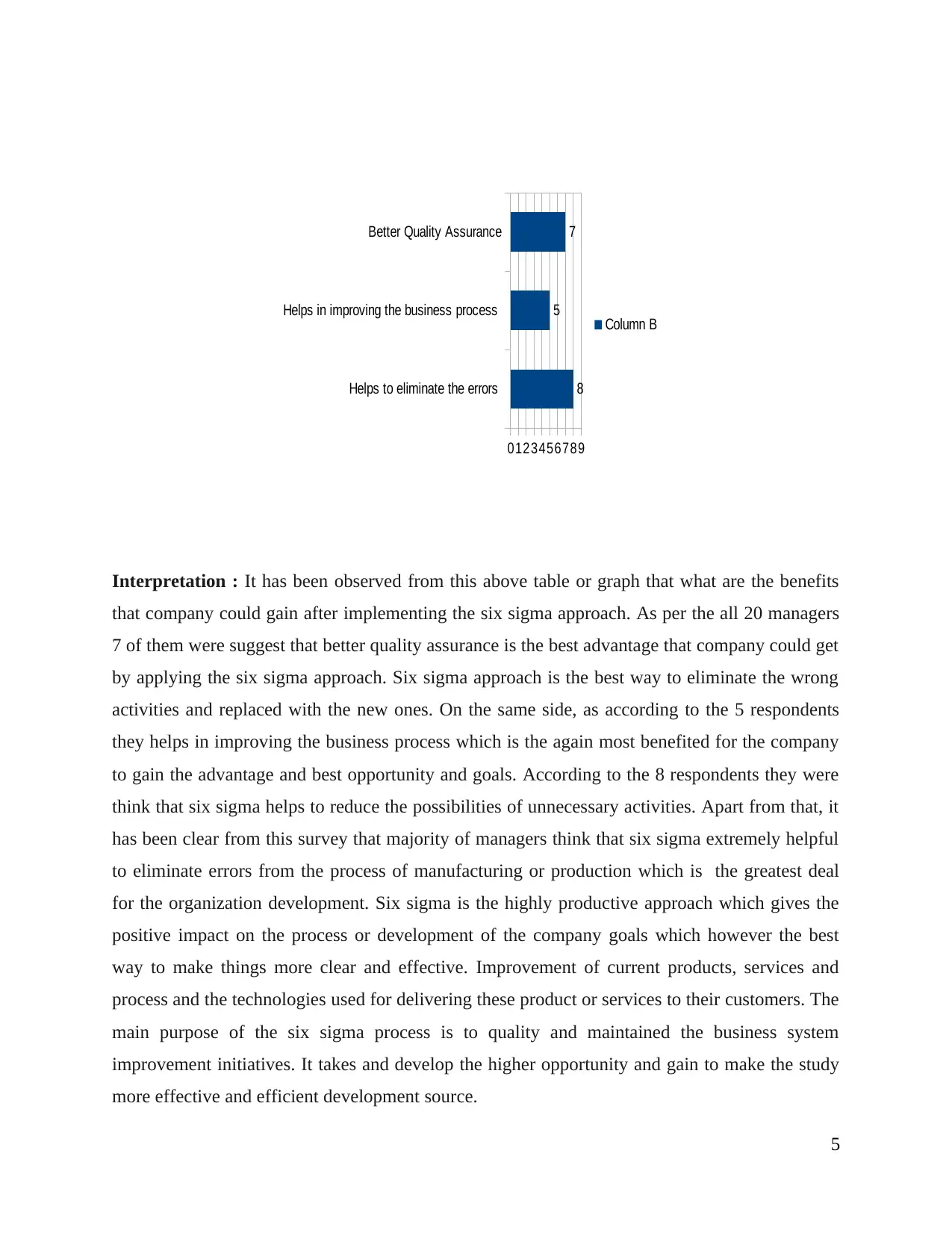
that company could gain after implementing the six sigma approach. As per the all 20 managers
7 of them were suggest that better quality assurance is the best advantage that company could get
by applying the six sigma approach. Six sigma approach is the best way to eliminate the wrong
activities and replaced with the new ones. On the same side, as according to the 5 respondents
they helps in improving the business process which is the again most benefited for the company
to gain the advantage and best opportunity and goals. According to the 8 respondents they were
think that six sigma helps to reduce the possibilities of unnecessary activities. Apart from that, it
has been clear from this survey that majority of managers think that six sigma extremely helpful
to eliminate errors from the process of manufacturing or production which is the greatest deal
for the organization development. Six sigma is the highly productive approach which gives the
positive impact on the process or development of the company goals which however the best
way to make things more clear and effective. Improvement of current products, services and
process and the technologies used for delivering these product or services to their customers. The
main purpose of the six sigma process is to quality and maintained the business system
improvement initiatives. It takes and develop the higher opportunity and gain to make the study
more effective and efficient development source.
5
Helps to eliminate the errors
Helps in improving the business process
Better Quality Assurance
0123456789
8
5
7
Column B

⊘ This is a preview!⊘
Do you want full access?
Subscribe today to unlock all pages.

Trusted by 1+ million students worldwide
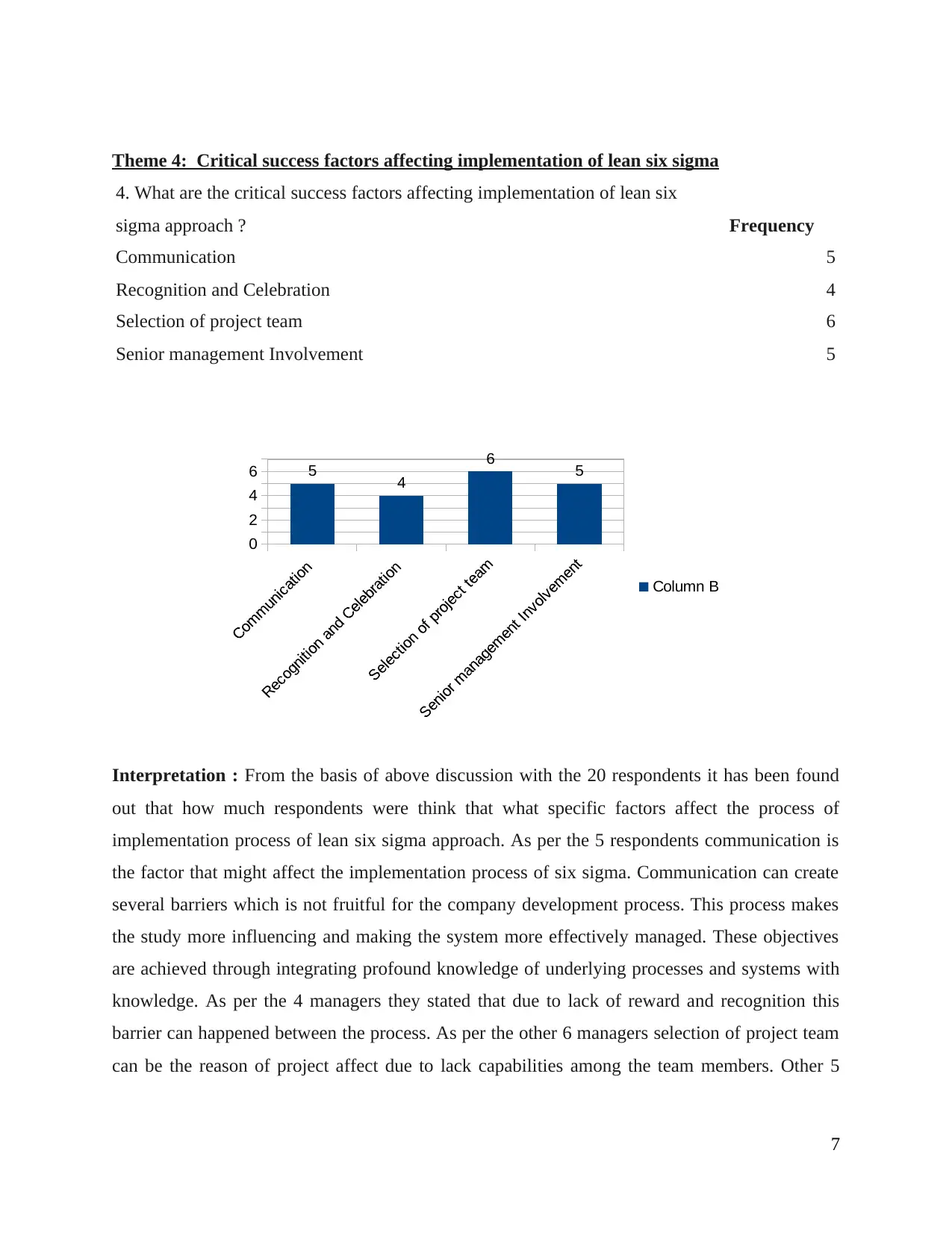
4. What are the critical success factors affecting implementation of lean six
sigma approach ? Frequency
Communication 5
Recognition and Celebration 4
Selection of project team 6
Senior management Involvement 5
Interpretation : From the basis of above discussion with the 20 respondents it has been found
out that how much respondents were think that what specific factors affect the process of
implementation process of lean six sigma approach. As per the 5 respondents communication is
the factor that might affect the implementation process of six sigma. Communication can create
several barriers which is not fruitful for the company development process. This process makes
the study more influencing and making the system more effectively managed. These objectives
are achieved through integrating profound knowledge of underlying processes and systems with
knowledge. As per the 4 managers they stated that due to lack of reward and recognition this
barrier can happened between the process. As per the other 6 managers selection of project team
can be the reason of project affect due to lack capabilities among the team members. Other 5
7
0
2
4
6 5 4
6 5
Column B
Paraphrase This Document
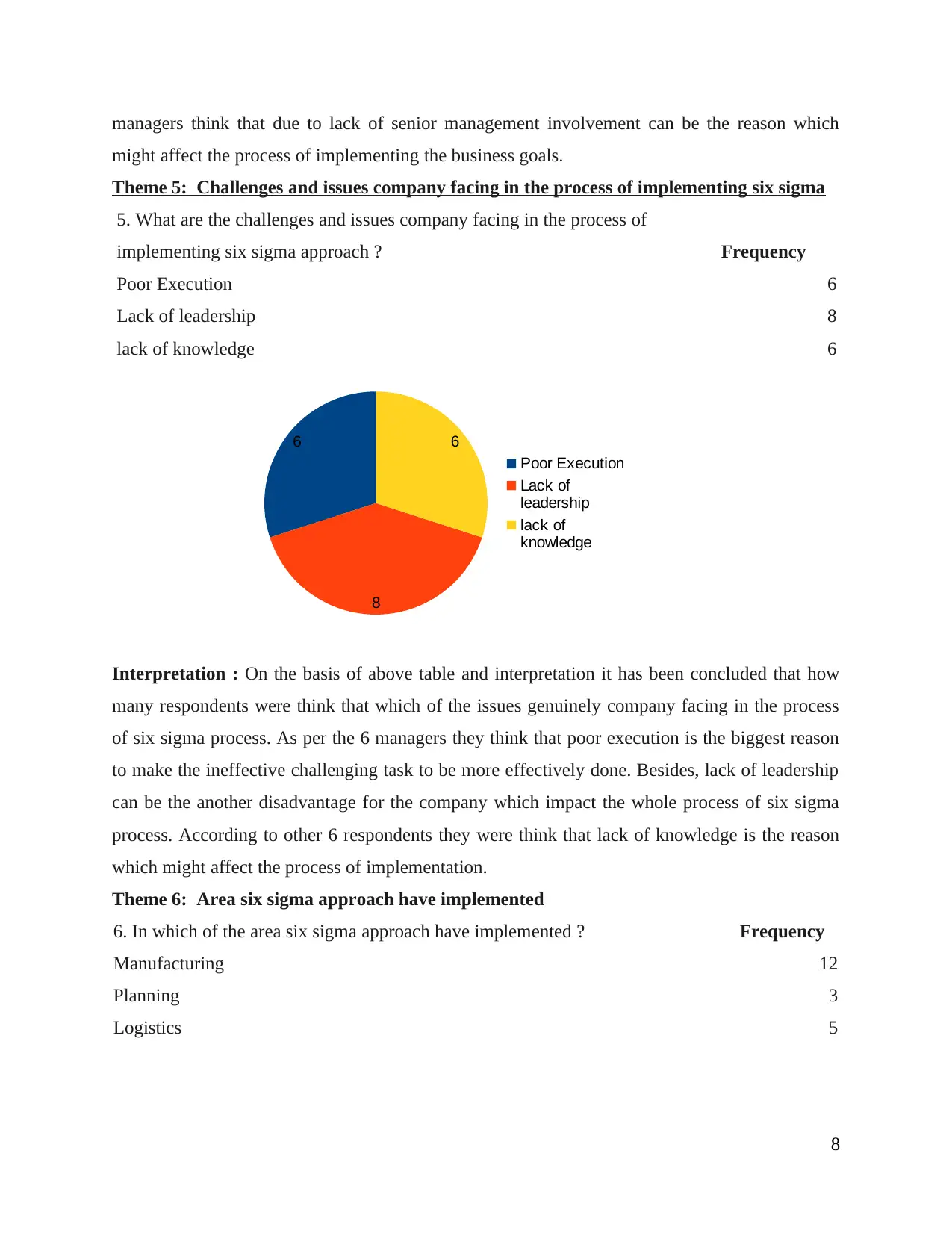
might affect the process of implementing the business goals.
Theme 5: Challenges and issues company facing in the process of implementing six sigma
5. What are the challenges and issues company facing in the process of
implementing six sigma approach ? Frequency
Poor Execution 6
Lack of leadership 8
lack of knowledge 6
Interpretation : On the basis of above table and interpretation it has been concluded that how
many respondents were think that which of the issues genuinely company facing in the process
of six sigma process. As per the 6 managers they think that poor execution is the biggest reason
to make the ineffective challenging task to be more effectively done. Besides, lack of leadership
can be the another disadvantage for the company which impact the whole process of six sigma
process. According to other 6 respondents they were think that lack of knowledge is the reason
which might affect the process of implementation.
Theme 6: Area six sigma approach have implemented
6. In which of the area six sigma approach have implemented ? Frequency
Manufacturing 12
Planning 3
Logistics 5
8
6
8
6
Poor Execution
Lack of
leadership
lack of
knowledge
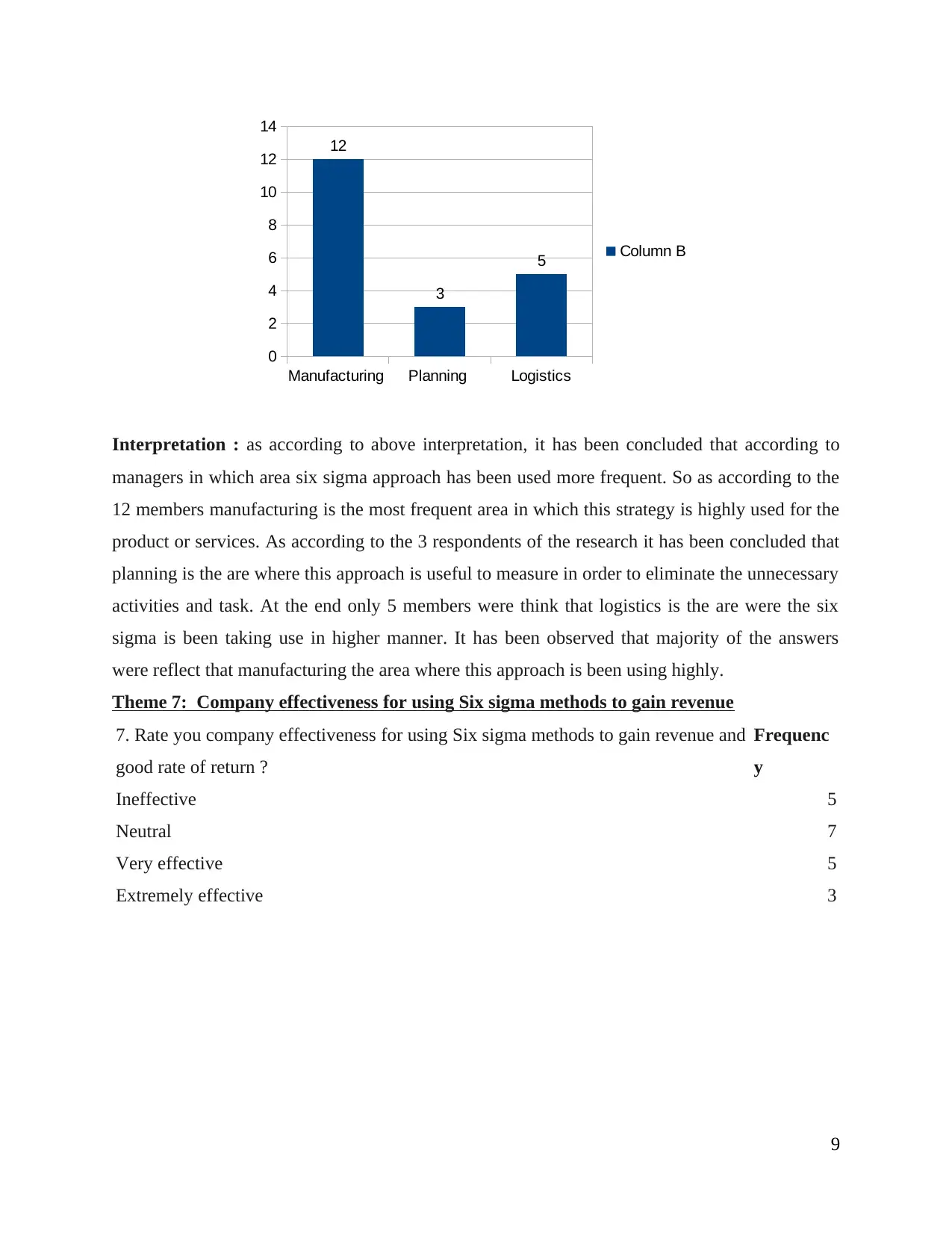
managers in which area six sigma approach has been used more frequent. So as according to the
12 members manufacturing is the most frequent area in which this strategy is highly used for the
product or services. As according to the 3 respondents of the research it has been concluded that
planning is the are where this approach is useful to measure in order to eliminate the unnecessary
activities and task. At the end only 5 members were think that logistics is the are were the six
sigma is been taking use in higher manner. It has been observed that majority of the answers
were reflect that manufacturing the area where this approach is been using highly.
Theme 7: Company effectiveness for using Six sigma methods to gain revenue
7. Rate you company effectiveness for using Six sigma methods to gain revenue and
good rate of return ?
Frequenc
y
Ineffective 5
Neutral 7
Very effective 5
Extremely effective 3
9
Manufacturing Planning Logistics
0
2
4
6
8
10
12
14
12
3
5 Column B
⊘ This is a preview!⊘
Do you want full access?
Subscribe today to unlock all pages.

Trusted by 1+ million students worldwide

managers suggested that weather six sigma approach is effective for the company or not. As
according to the 5 respondents this technique or approach is the best way to measure the
opportunity or task to full fill the aims and objectives of the results and goals. As according to 4
managers there reaction was neutral they were stated that six sigma moderately good or bad for
the process of manufacturing. Besides that, according to five managers six sigma is highly
effective for the company that makes the quality of product or services and give the good impact
on the business performance. On the same side, another it makes the study more effectively
managed and influencing the business task. As according to the 3 they were stated that six sigma
approach is extremely effective for the business process.
Theme 8 : Six sigma plan
8. Six sigma has been good investment for your company or not ? Frequency
Yes 15
No 5
10
5
7
5
3
Ineffective
Neutral
Very effective
Extremely effective
Paraphrase This Document
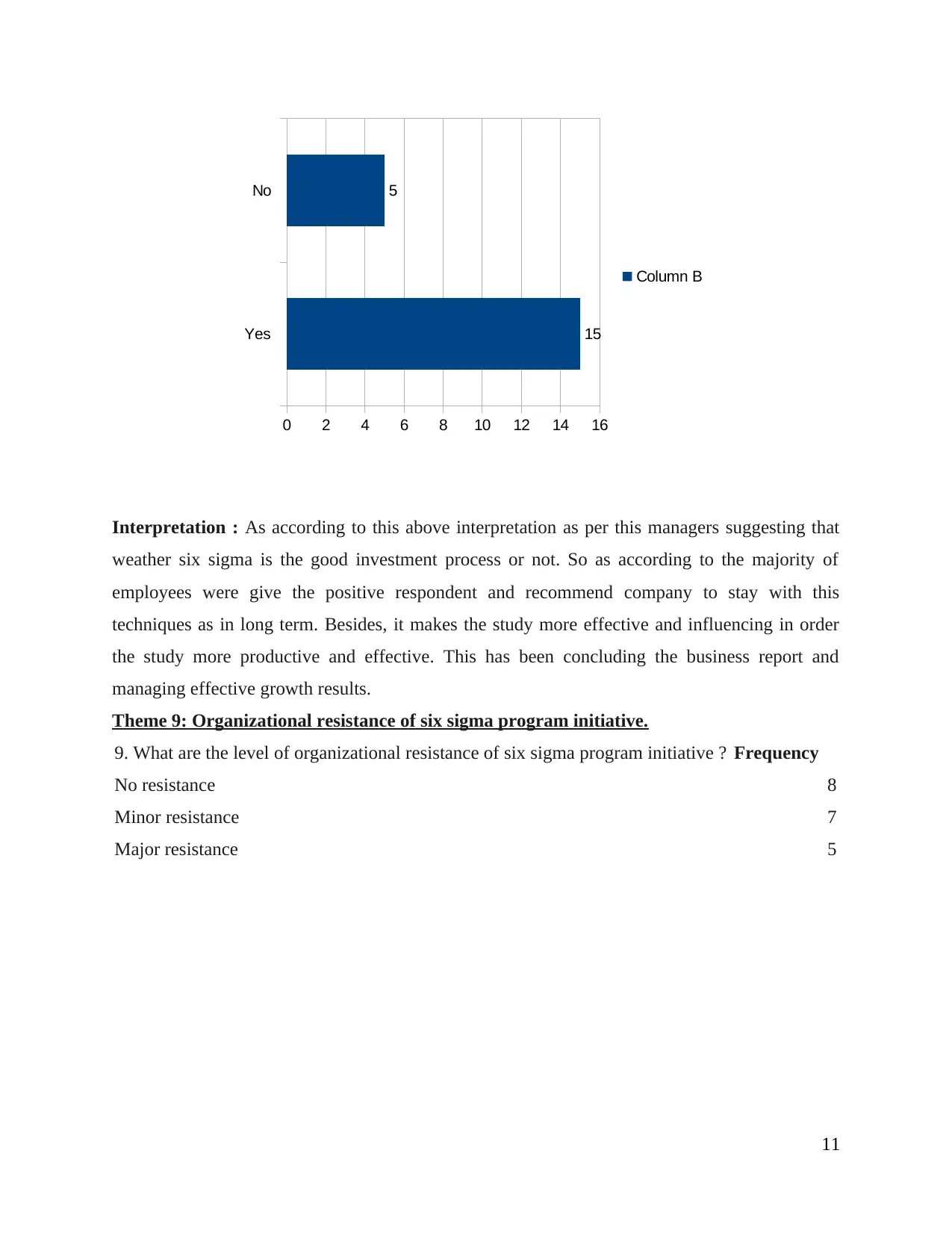
weather six sigma is the good investment process or not. So as according to the majority of
employees were give the positive respondent and recommend company to stay with this
techniques as in long term. Besides, it makes the study more effective and influencing in order
the study more productive and effective. This has been concluding the business report and
managing effective growth results.
Theme 9: Organizational resistance of six sigma program initiative.
9. What are the level of organizational resistance of six sigma program initiative ? Frequency
No resistance 8
Minor resistance 7
Major resistance 5
11
Yes
No
0 2 4 6 8 10 12 14 16
15
5
Column B

much employee resist with new change or some new implementation process of generating
operating results. As according to 8 employees they stated that no resistance found among
employees in the context of new change. Besides that, as according to the seven respondents
minor resistance found among employees due to new sudden changes within the working
process. On the same side, as according to the 5 managers they stated that there has been found
major resistance among employees in order to make better understand the activities which better
understand the goals and objectives. However, this has been interpretative that it makes the
things indifferent ineffective interns of making new challenges and growth.
Theme 10 : External consultants helps H&M in the process of planning execution
10. Were external consultants helps H&M in the process of planning execution of
six program ? Frequency
Yes 15
No 5
12
No resistance Minor resistance Major resistance
0
1
2
3
4
5
6
7
8
9
8
7
5
Column B
⊘ This is a preview!⊘
Do you want full access?
Subscribe today to unlock all pages.

Trusted by 1+ million students worldwide
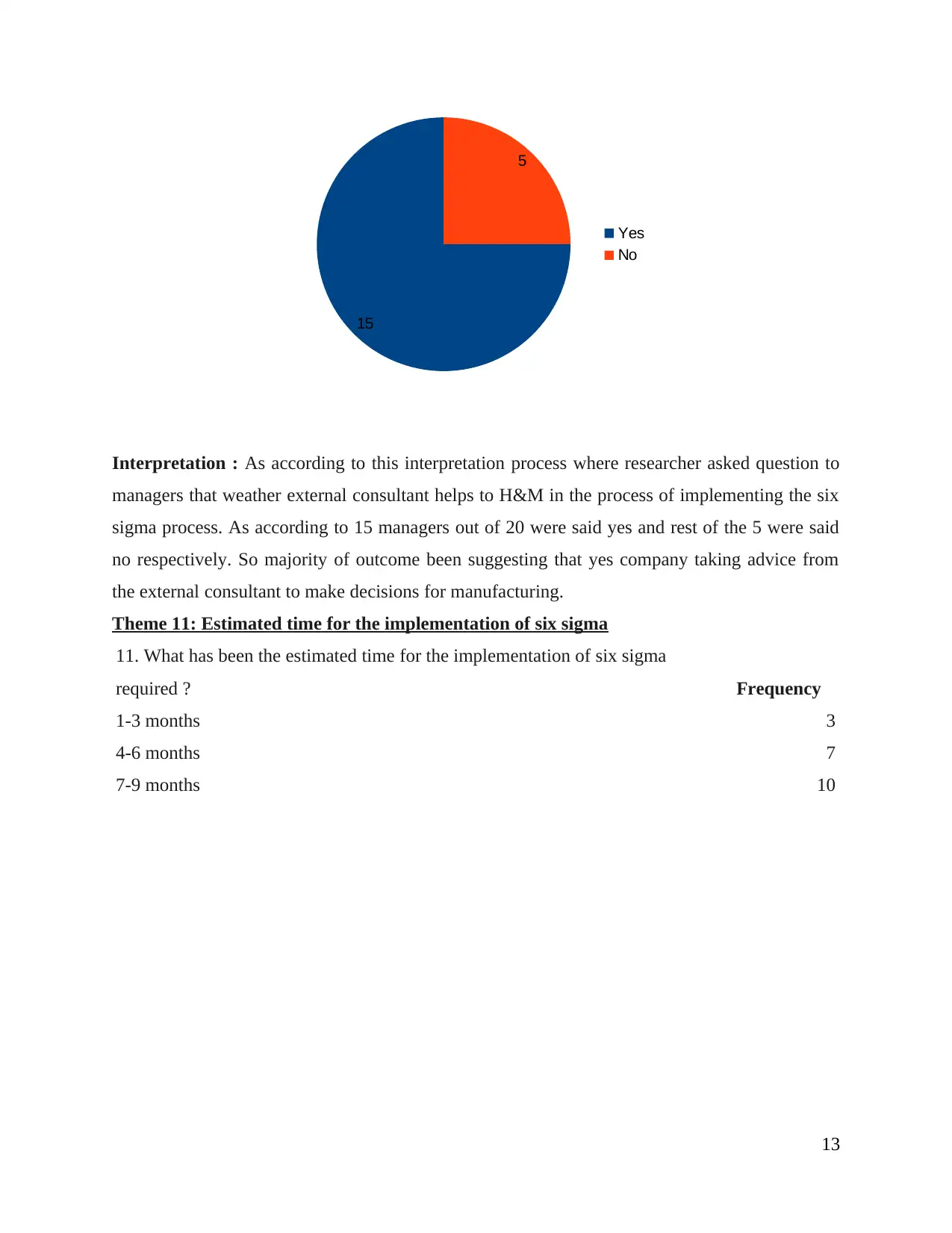
managers that weather external consultant helps to H&M in the process of implementing the six
sigma process. As according to 15 managers out of 20 were said yes and rest of the 5 were said
no respectively. So majority of outcome been suggesting that yes company taking advice from
the external consultant to make decisions for manufacturing.
Theme 11: Estimated time for the implementation of six sigma
11. What has been the estimated time for the implementation of six sigma
required ? Frequency
1-3 months 3
4-6 months 7
7-9 months 10
13
15
5
Yes
No
Paraphrase This Document

much managers think that six sigma taking time to implement. So as according to the 3 members
they stated that it will take 1 to 3 months of implementation. On the other side, seven managers
thinks that it will take 4-6 months to manage the outcome and goals on the same hand as per the
10 respondents they thinks that this process will approximately take 7-9 months time to settle
down within the business environment.
Theme 12 : Communication media were used to overcome the resistance of six sigma
12. Which of the communication media were used to overcome the resistance of six
sigma ? Frequency
Conducted workshops 5
Newsletter 5
Video/Visits of other companies 10
14
1-3 months 4-6 months 7-9 months
0
2
4
6
8
10
12
3
7
10
Column B

following medium helps company to get through from the resistance of change. So as according
to the 20 managers. 5 of them were stated that conducted workshop is the way to conduct the
process of change or might it helps to better understand the things more quickly. As according to
other 5 respondents newsletter is the medium which helps to resists the new change and rest of
the 10 respondents where think that video and visitors of the other company will more helpful to
generate the new leads.
Theme 13 : Any valuable review or suggestion you would like to share regarding Six sigma
program ?
15
Conducted workshops
Newsletter
Video/Visits of other companies
0
4
8
12
5 5
10
Column B
⊘ This is a preview!⊘
Do you want full access?
Subscribe today to unlock all pages.

Trusted by 1+ million students worldwide
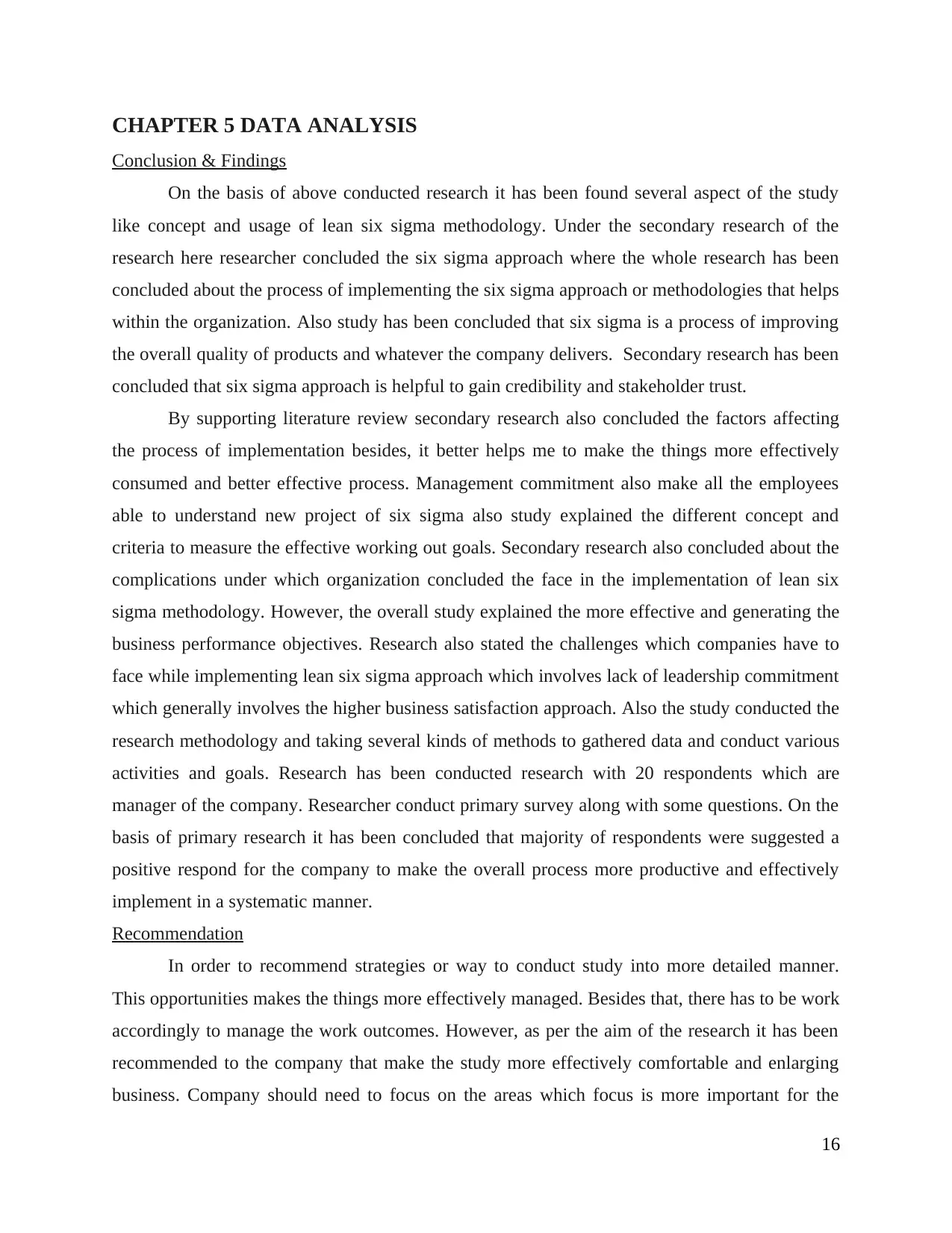
Conclusion & Findings
On the basis of above conducted research it has been found several aspect of the study
like concept and usage of lean six sigma methodology. Under the secondary research of the
research here researcher concluded the six sigma approach where the whole research has been
concluded about the process of implementing the six sigma approach or methodologies that helps
within the organization. Also study has been concluded that six sigma is a process of improving
the overall quality of products and whatever the company delivers. Secondary research has been
concluded that six sigma approach is helpful to gain credibility and stakeholder trust.
By supporting literature review secondary research also concluded the factors affecting
the process of implementation besides, it better helps me to make the things more effectively
consumed and better effective process. Management commitment also make all the employees
able to understand new project of six sigma also study explained the different concept and
criteria to measure the effective working out goals. Secondary research also concluded about the
complications under which organization concluded the face in the implementation of lean six
sigma methodology. However, the overall study explained the more effective and generating the
business performance objectives. Research also stated the challenges which companies have to
face while implementing lean six sigma approach which involves lack of leadership commitment
which generally involves the higher business satisfaction approach. Also the study conducted the
research methodology and taking several kinds of methods to gathered data and conduct various
activities and goals. Research has been conducted research with 20 respondents which are
manager of the company. Researcher conduct primary survey along with some questions. On the
basis of primary research it has been concluded that majority of respondents were suggested a
positive respond for the company to make the overall process more productive and effectively
implement in a systematic manner.
Recommendation
In order to recommend strategies or way to conduct study into more detailed manner.
This opportunities makes the things more effectively managed. Besides that, there has to be work
accordingly to manage the work outcomes. However, as per the aim of the research it has been
recommended to the company that make the study more effectively comfortable and enlarging
business. Company should need to focus on the areas which focus is more important for the
16
Paraphrase This Document
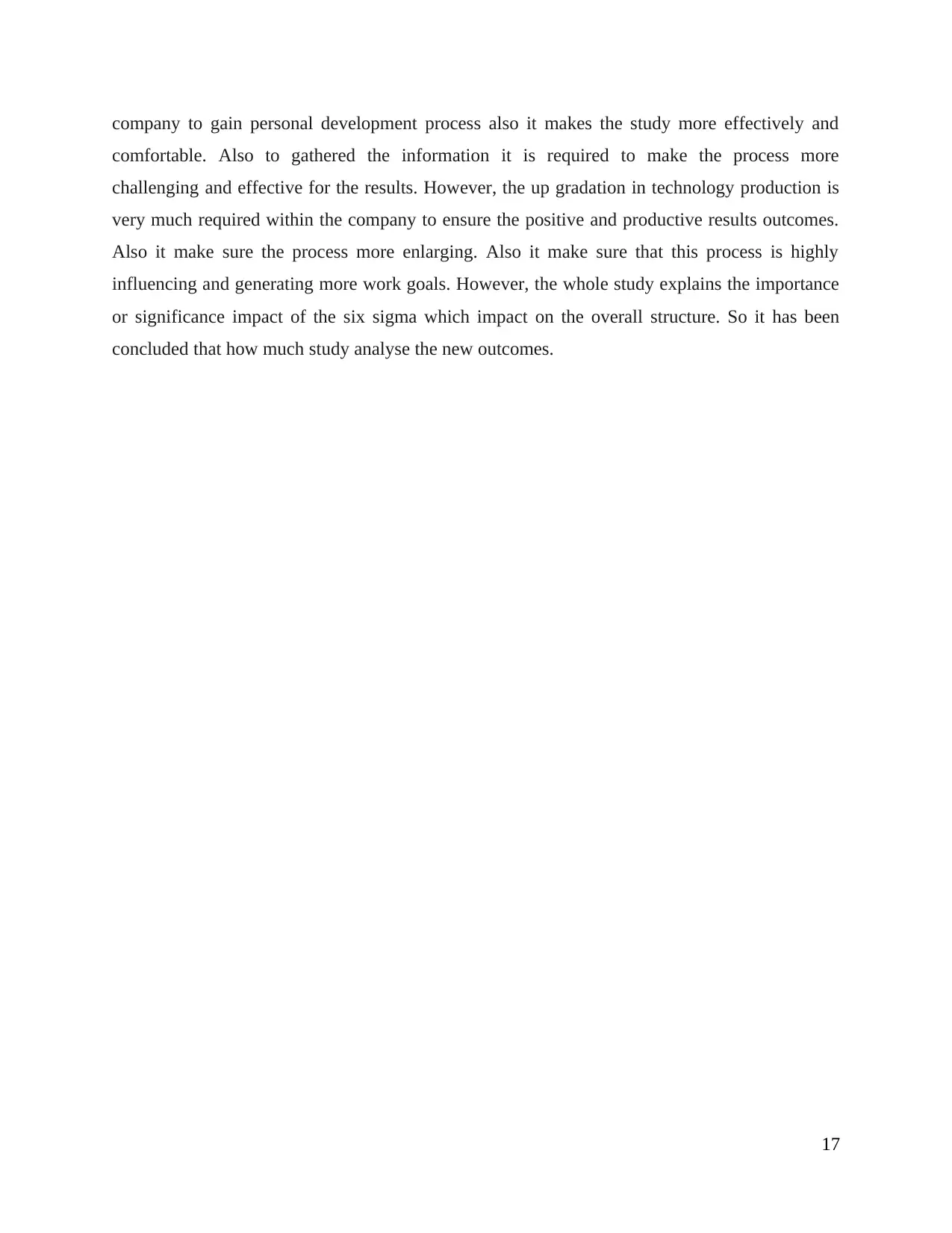
comfortable. Also to gathered the information it is required to make the process more
challenging and effective for the results. However, the up gradation in technology production is
very much required within the company to ensure the positive and productive results outcomes.
Also it make sure the process more enlarging. Also it make sure that this process is highly
influencing and generating more work goals. However, the whole study explains the importance
or significance impact of the six sigma which impact on the overall structure. So it has been
concluded that how much study analyse the new outcomes.
17
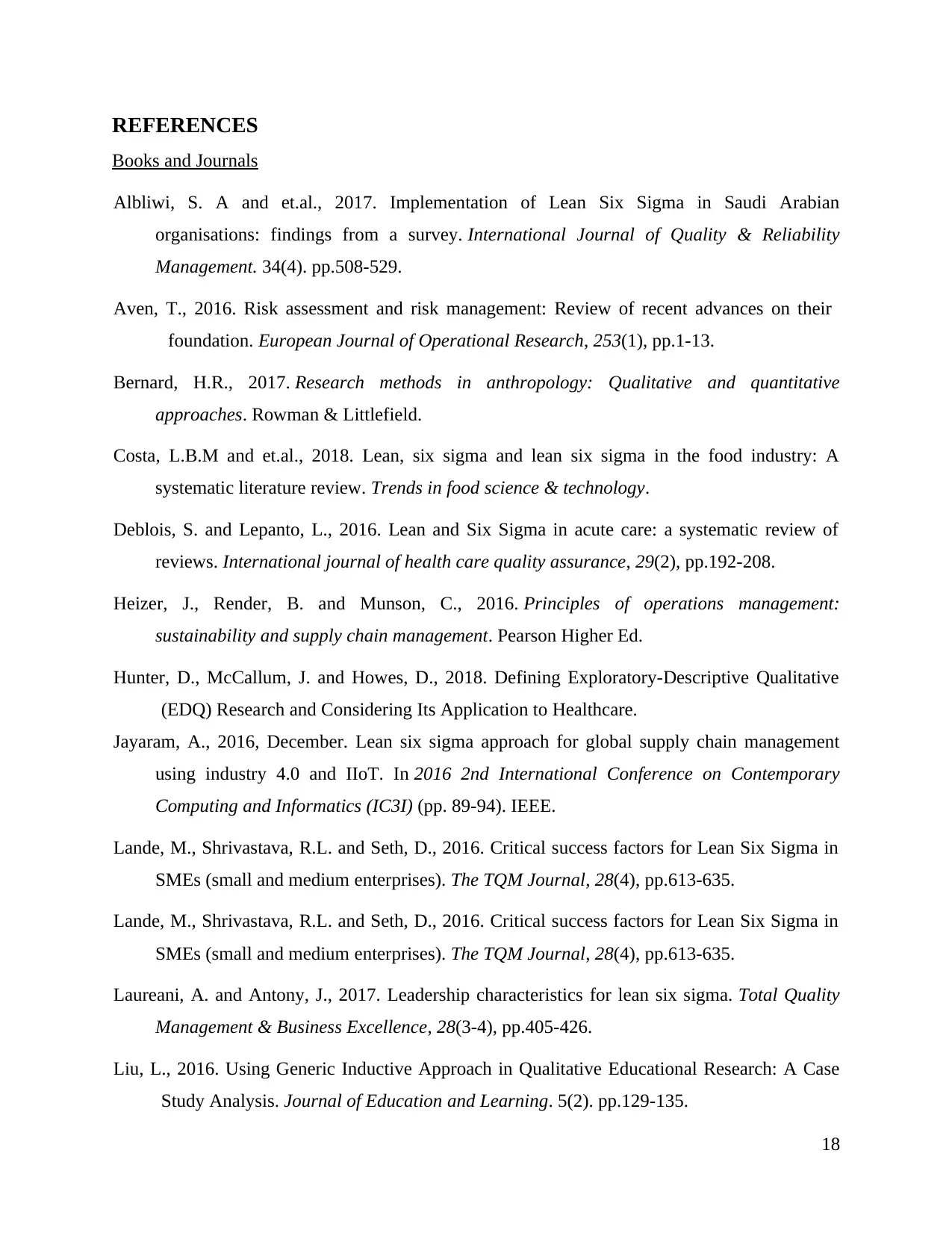
Books and Journals
Albliwi, S. A and et.al., 2017. Implementation of Lean Six Sigma in Saudi Arabian
organisations: findings from a survey. International Journal of Quality & Reliability
Management. 34(4). pp.508-529.
Aven, T., 2016. Risk assessment and risk management: Review of recent advances on their
foundation. European Journal of Operational Research, 253(1), pp.1-13.
Bernard, H.R., 2017. Research methods in anthropology: Qualitative and quantitative
approaches. Rowman & Littlefield.
Costa, L.B.M and et.al., 2018. Lean, six sigma and lean six sigma in the food industry: A
systematic literature review. Trends in food science & technology.
Deblois, S. and Lepanto, L., 2016. Lean and Six Sigma in acute care: a systematic review of
reviews. International journal of health care quality assurance, 29(2), pp.192-208.
Heizer, J., Render, B. and Munson, C., 2016. Principles of operations management:
sustainability and supply chain management. Pearson Higher Ed.
Hunter, D., McCallum, J. and Howes, D., 2018. Defining Exploratory-Descriptive Qualitative
(EDQ) Research and Considering Its Application to Healthcare.
Jayaram, A., 2016, December. Lean six sigma approach for global supply chain management
using industry 4.0 and IIoT. In 2016 2nd International Conference on Contemporary
Computing and Informatics (IC3I) (pp. 89-94). IEEE.
Lande, M., Shrivastava, R.L. and Seth, D., 2016. Critical success factors for Lean Six Sigma in
SMEs (small and medium enterprises). The TQM Journal, 28(4), pp.613-635.
Lande, M., Shrivastava, R.L. and Seth, D., 2016. Critical success factors for Lean Six Sigma in
SMEs (small and medium enterprises). The TQM Journal, 28(4), pp.613-635.
Laureani, A. and Antony, J., 2017. Leadership characteristics for lean six sigma. Total Quality
Management & Business Excellence, 28(3-4), pp.405-426.
Liu, L., 2016. Using Generic Inductive Approach in Qualitative Educational Research: A Case
Study Analysis. Journal of Education and Learning. 5(2). pp.129-135.
18
⊘ This is a preview!⊘
Do you want full access?
Subscribe today to unlock all pages.

Trusted by 1+ million students worldwide

Higher Ed.
Mason, S.E., Nicolay, C.R. and Darzi, A., 2015. The use of Lean and Six Sigma methodologies
in surgery: A systematic review. The Surgeon, 13(2), pp.91-100.
Mihas, P., 2019. Qualitative data analysis. In Oxford Research Encyclopedia of Education.
Muturi, D and et.al., 2015. The implementation of Lean Six Sigma concept at national bank of
Kenya-operation division. The TQM Journal.
Neelankavil, J.P., 2015. Primary Data Collection: Exploratory Research. In International
Business Research (pp. 122-145). Routledge.
Opie, C., 2019. Research approaches. Getting Started in Your Educational Research: Design,
Data Production and Analysis, p.137.
Robertson, A. and Sibley, C.G., 2018. Research sampling: a pragmatic approach. In Advanced
Research Methods for Applied Psychology (pp. 27-48). Routledge.
Ryan, G., 2018. Introduction to positivism, interpretivism and critical theory. Nurse researcher.
25(4). pp.41-49.
Ryen, A., 2016. Research ethics and qualitative research. Qualitative research, pp.31-46.
Shahid, S., 2015. Lack of leadership. In World Economic Forum.
Shamsuzzaman, M and et.al., 2018. Using Lean Six Sigma to improve mobile order fulfilment
process in a telecom service sector. Production Planning & Control, 29(4), pp.301-314.
Shinoda, T., 2018. Koizumi’s top-down leadership in the anti-terrorism legislation: the impact of
political institutional changes. In Critical Readings on the Liberal Democratic Party in
Japan (pp. 1543-1556). BRILL.
Shokri, A., Waring, T.S. and Nabhani, F., 2016. Investigating the readiness of people in
manufacturing SMEs to embark on Lean Six Sigma projects: An empirical study in the
German manufacturing sector. International Journal of Operations & Production
Management, 36(8), pp.850-878.
Sunder M, V., 2016. Rejects reduction in a retail bank using Lean Six Sigma. Production
Planning & Control, 27(14), pp.1131-1142.
19
Paraphrase This Document

for new product development. Computers & Industrial Engineering, 98, pp.522-530.
Yadav, G., Seth, D. and Desai, T.N., 2017. Analysis of research trends and constructs in context
to lean six sigma frameworks. Journal of Manufacturing Technology Management. 28(6).
pp.794-821.
Yeakley, DD and et.al., 2016. Data collection system having reconfigurable data collection
terminal. U.S. Patent 9,256,772.
Zhang, A and et.al., 2016. Lean and Six Sigma in logistics: A pilot survey study in
Singapore. International Journal of Operations & Production Management, 36(11),
pp.1625-1643.
Online:
Complication's organisation faced in the implementation of Lean Six Sigma methodology. 2018.
[ONLINE]. Available through: <https://www.sixsigmadaily.com/what-are-common-
challenges-when-implementing-six-sigma-in-organizations/>.
Critical Success Factors of Implementation of Six Sigma. 2018. [ONLINE]. Available through:
<https://www.isixsigma.com/implementation/success-factors/six-sigma-critical-success-
factors/>.
Six sigma by H&M. 2018. [ONLINE]. Available through:
<https://www.henryharvin.com/downloads/HenryHarvin-1443521758-Fashion
%20Technology.pdf>.
20
Related Documents
Your All-in-One AI-Powered Toolkit for Academic Success.
+13062052269
info@desklib.com
Available 24*7 on WhatsApp / Email
![[object Object]](/_next/static/media/star-bottom.7253800d.svg)
© 2024 | Zucol Services PVT LTD | All rights reserved.





